Cassiopeia is a large constellation located in the northern sky. It was named after Cassiopeia, the vain and boastful queen in Greek mythology. Nicknamed the W constellation, Cassiopeia is easily recognizable for the prominent W asterism formed by its five brightest stars.
The constellation Cassiopeia was first catalogued by the Greek astronomer Ptolemy in the 2nd century CE, along with other Greek constellations.
Cassiopeia contains many notable deep sky objects, among them the open clusters Messier 52 and Messier 103, the Bubble Nebula, the Heart Nebula and the Soul Nebula, the Little Rosette Nebula, the supernova remnants Cassiopeia A and Tycho’s Supernova, the Owl Cluster, Caroline’s Rose Cluster, and the star-forming cloud popularly known as the Pacman Nebula.
Facts, location and map
Cassiopeia is the 25th largest constellation in the night sky, occupying an area of 598 square degrees. It lies in the first quadrant of the northern hemisphere (NQ1). The entire constellation can be seen from locations between the latitudes +90° and -20°. The neighboring constellations are Andromeda, Camelopardalis, Cepheus, Lacerta, and Perseus.
The constellation name Cassiopeia is pronounced /ˌkæsioʊˈpiːə/. In English, the constellation is known as Cassiopeia, the Queen, or the Seated Queen. The genitive form of Cassiopeia, used in star names, is Cassiopeiae (pronunciation: /ˌkæsioʊˈpiːiː/). The three-letter abbreviation, adopted by the International Astronomical Union (IAU) in 1922, is Cas.
Cassiopeia belongs to the Perseus family of constellations, along with Andromeda, Auriga, Cepheus, Cetus, Lacerta, Pegasus, Perseus, and Triangulum.
The brightest star in the constellation is Schedar, Alpha Cassiopeiae. Schedar shines at magnitude 2.240 from a distance of 228 light-years. It is one of the 157 visible stars in the constellation (brighter than or equal to magnitude 6.5). The nearest star in Cassiopeia is Achird (Eta Cassiopeiae), located 19.32 light-years away.
Cassiopeia has 14 stars with known planets and 10 names stars. The proper names of stars that have been officially approved by the International Astronomical Union (IAU) are Achird (Eta Cassiopeiae A), Caph (Beta Cassiopeiae), Castula (Upsilon2 Cassiopeiae), Cexing (Kappa Cassiopeiae), Fulu (Zeta Cassiopeiae), Nushagak (HD 17156), Ruchbah (Delta Cassiopeiae Aa), Schedar (Alpha Cassiopeiae), Segin (Epsilon Cassiopeiae), and Tiansi (Gamma Cassiopeiae Aa).
The constellation contains two Messier objects: Messier 103 (NGC 581) and Messier 52 (NGC 7654). It is associated with a single meteor shower, the December Phi Cassiopeiids. The Perseid meteor shower is also associated with the constellation.
The best time of the year to see Cassiopeia is during the month of November, when the constellation appears higher above the horizon around 9 pm.
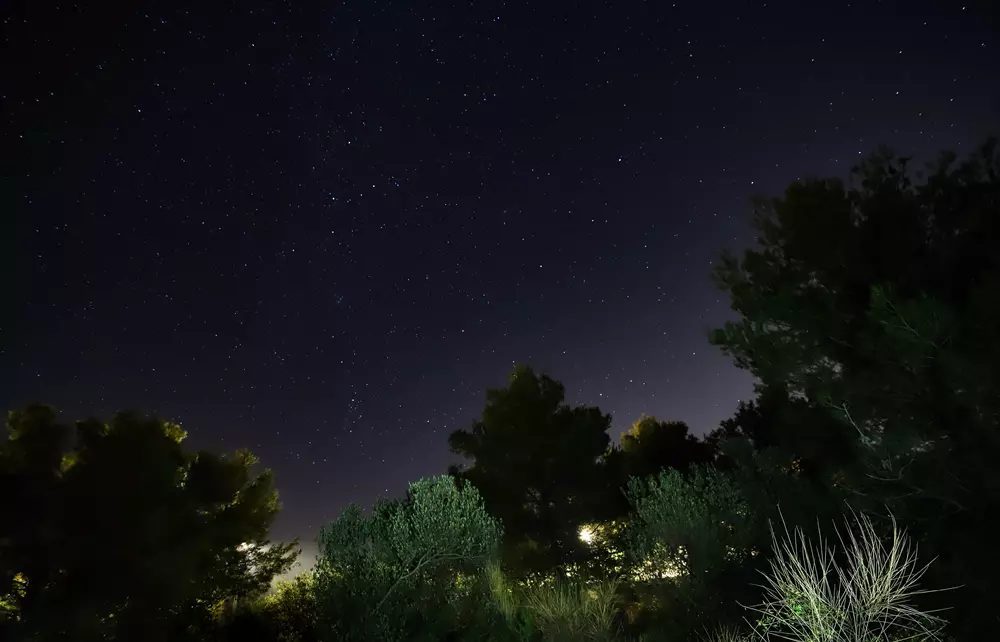
Cassiopeia, image: Constellation Guide
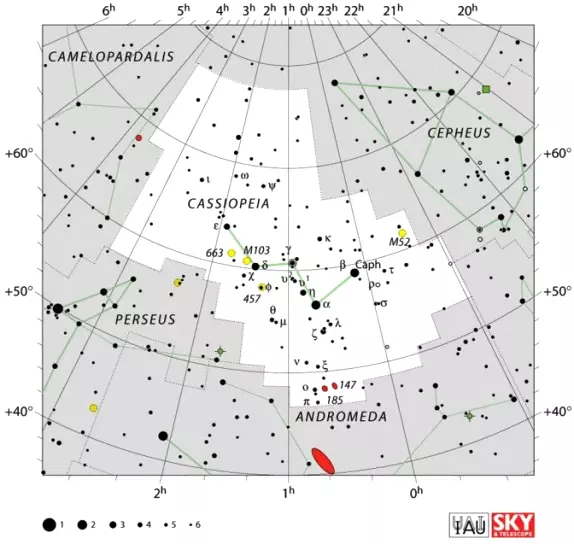
Cassiopeia constellation map by IAU and Sky&Telescope magazine (Roger Sinnott & Rick Fienberg) (CC BY 3.0)
Myth
In mythology, the Queen Cassiopeia was the wife of King Cepheus of Aethiopia (represented by the neighbouring constellation Cepheus in the sky) and the mother of the princess Andromeda. In Greek lore, the vain queen boasted that she was more beautiful than the Nereids (or alternatively, that her daughter Andromeda was more beautiful). The Nereids were the 50 sea nymphs fathered by the Titan Nereus. They were enraged by Cassiopeia’s comments and appealed to the god Poseidon to punish Cassiopeia for her boastfulness. The god of the sea was married to one of the nymphs, Amphitrite, and had to oblige.
The sea god sent Cetus, a sea monster represented by the constellation Cetus (the Whale), to ravage the coast of Cepheus’ kingdom.
Cepheus turned to an oracle for help and the oracle told him that, in order to appease Poseidon, he and Cassiopeia had to sacrifice their daughter to the sea monster. Reluctantly, the king and queen did so, leaving Andromeda chained to a rock for the monster to find. However, the monster did not get to her. The princess was saved in the last minute by the Greek hero Perseus. Perseus happened to be passing by, he saw Andromeda, and rescued her from the monster.
Perseus and Andromeda were later married. At the wedding, one of Andromeda’s former suitors, named Phineus, appeared and claimed that he was the only one who had the right to marry her. There was a fight and Perseus was desperately outnumbered. He used the head of the Gorgon Medusa to defeat his opponents. One look at Medusa’s head turned them all into stone. However, the king and queen also met their end because they did not look away from the monster’s head in time.
It was Poseidon who placed Cassiopeia and Cepheus in the sky. However, as punishment for her vanity, Cassiopeia was condemned to circle the north celestial pole forever, and spends half the year upside down in the sky. The queen is usually depicted on her throne, still combing her hair.
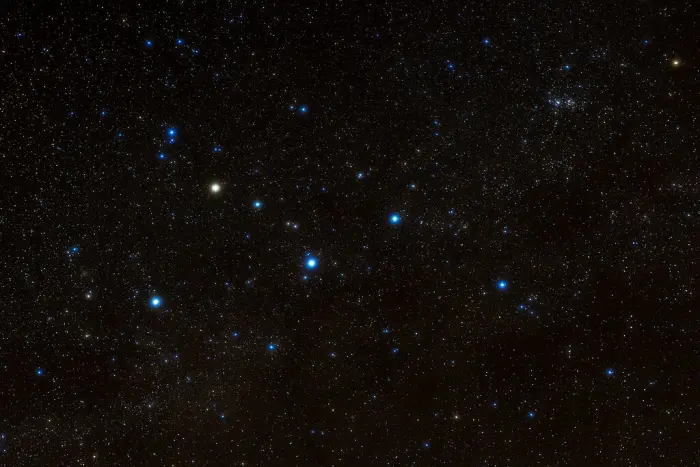
Taken in November 2019 from the Doi Inthanon National Park, Chiang Mai, Thailand, this image captures the notable northern constellation Cassiopeia, in the shape of the letter M. Although the official constellation name is the Latinised version of the name of queen “Kasseipeia” from Greek mythology, these five bright stars were considered a constellation in many cultures around the world and they are associated with diverse stories. In Thailand, for example, the constellation represents a Bat, while in Hawaiian culture it is called ‘Iwa Keli’i, the chief frigate bird. For the Navajo in North America, the bright stars are the central part of the celestial mother (of all stars and humans) revolving around the celestial pole together with her husband, the celestial father (of all stars and humans) seen in the constellation of Ursa Major. For the Maya it was part of the huge constellation of the Hole-Backed Caiman, and for the Inuit a Lamp Stand and a Blubber Container. In ancient China, the bottom-left star was associated with the mythological general Wangliang who drove four horses, represented by the two bright and two fainter stars of the M’s next stroke (from upper-left to lower-middle). The remaining two bright stars and a couple of the other fainter ones are considered a Flying Corridor, a sort of highway, next to the Emperor’s Forbidden Palace that is located at the northern polar region. On the island of Tonga in the South Pacific, this asterism is considered the Wing of Tafahi and it is not clear if this refers to the shape of the island of Tafahi, or if it is based on an error and originally referred to a wing of the Polynesian hero Tafaki. The various colours of the stars indicate their temperatures, with redder stars being relatively cooler on their surface than blue and white stars. Image credit: Thanakrit Santikunaporn/IAU OAE (CC BY 4.0)
Asterisms
Cassiopeia hosts one of the most familiar asterisms in the northern celestial hemisphere. The constellation’s five brightest stars form Cassiopeia’s W, a W-shaped pattern that easily stands out in the northern sky.
Cassiopeia’s W
Cassiopeia’s W is a bright asterism formed by Schedar (Alpha Cassiopeiae), Caph (Beta Cassiopeiae), Tiansi (Gamma Cassiopeiae), Ruchbah (Delta Cassiopeiae), and Segin (Epsilon Cassiopeiae). Four of these are evolved stars and Segin, the leftmost star of the W, is still on the main sequence.
All five stars of Cassiopeia’s W are much larger, more massive and more luminous than the Sun. Segin and Gamma Cassiopeiae are both luminous B-type stars that will likely end their lives as supernovae, while Schedar, Caph and Ruchbah will produce planetary nebulae at the end of their lives.
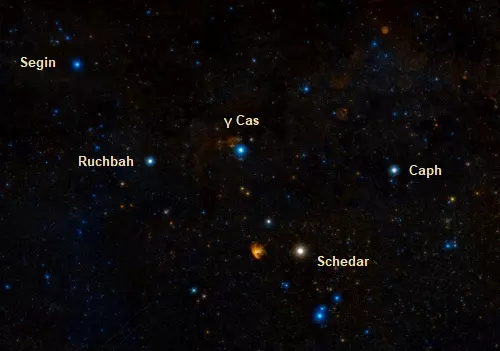
The five stars of Cassiopeia’s W, image: Wikisky (DSS2)
The asterism looks like a W when it appears below Polaris (the North Star) during the northern hemisphere spring and summer. During northern winter, it appears above Polaris and looks like an M. When seen from the southern hemisphere, it always looks like an M.
Cassiopeia’s W and the Big Dipper in Ursa Major can be used to find Polaris and the north celestial pole. The North Star is the brightest star lying roughly halfway between the two asterisms. It appears along the imaginary line extended from Segin to Mizar, Schedar to Megrez, Ruchbah to Alioth, or Caph to Phecda. The easiest way to find Polaris is by extending a line from Merak through Dubhe, the outer stars of the Big Dipper’s bowl.
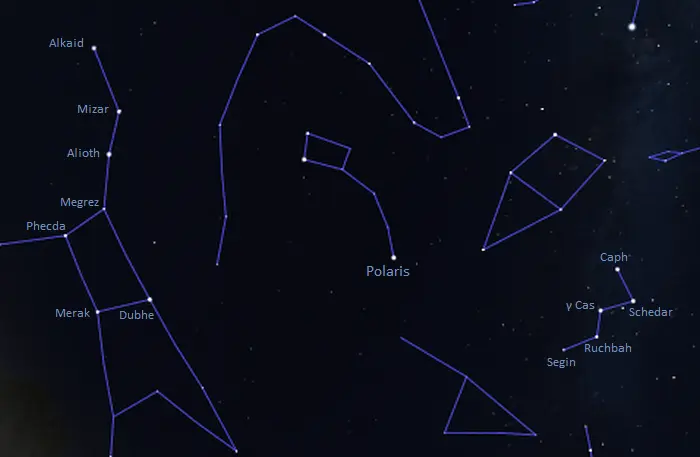
Polaris, the Big Dipper and Cassiopeia, image: Stellarium
Major stars in Cassiopeia
Cassiopeia contains many exceptionally large, massive and luminous stars. The constellation’s five brightest stars form Cassiopeia’s W, a recognizable star pattern that makes it easy to locate other stars in the constellation, as well as Cassiopeia’s many bright deep sky objects.
The Cassiopeia constellation hosts 157 visible stars (brighter than magnitude 6.5). It does not contain any first magnitude stars. The brightest stars in the constellation, Schedar (Alpha Cassiopeiae), Caph (Beta Cassiopeiae), and Tiansi (Gamma Cassiopeiae), shine at second magnitude. Ruchbah (Delta Cassiopeiae) is the only other star brighter than magnitude 3.0, and Segin (Epsilon Cassiopeiae), Achird (Eta Cassiopeiae), Fulu (Zeta Cassiopeiae), and 50 Cassiopeiae are brighter than magnitude 4.0.
Schedar – α Cassiopeiae (Alpha Cassiopeiae)
Schedar (α Cas) is the brightest star in Cassiopeia. It shines at magnitude 2.240 from a distance of 228 light-years.
Schedar is a red giant of the spectral type K0-IIIa. It has 3.98 times the Sun’s mass and a radius 45.03 times the Sun’s. With an effective temperature of 4,476 K, it is around 734 times more luminous than the Sun.
The evolved star has an estimated age of 220 million years, which is only a fraction of the Sun’s age (4.6 billion years). The orange giant burned through its supply of hydrogen fuel faster due to its high mass and will reach the end of its life much sooner than the Sun.
Schedar is not massive enough to go out as a supernova. Instead, when it comes to the end of its life cycle, it will expel its outer layers, producing a bright planetary nebula, and slowly fade as a white dwarf for billions of years.
The star’s traditional name, Schedar, is derived from the Arabic şadr, which means “breast.” The name refers to the star’s position in the constellation, marking Cassiopeia’s heart. It was historically also spelled Schedir, Sheder, Shedar, Shedir, Seder, and Shadar.
The earliest known record of the name comes from the 13th century Alfonsine Tables, a series of astronomical tables compiled in Toledo, Spain, that provided the exact times for the rising of stars and planets.
Caph – β Cassiopeiae (Beta Cassiopeiae)
Caph (β Cas) is an F-type giant star located 54.7 light-years away. With an apparent magnitude of 2.28, it is the second brightest star in Cassiopeia.
Caph has a mass of 1.91 solar masses and a radius of 3.43 – 3.69 solar radii. It is classified as a Delta Scuti variable, a young pulsating star whose radius changes with the pulsations. The star’s brightness varies from magnitude 2.25 to 2.31 with a period of 2.5 hours.
Caph is the fourth brightest Delta Scuti variable in the sky, after Vega in the constellation Lyra, Altair in Aquila, and Denebola in Leo.
Beta Cassiopeiae is 27.3 times more luminous than the Sun. It has a surface temperature of 7,079 K and it spins at 71 km/s. The fast rotation rate is giving the star the shape of an oblate spheroid. Like other fast spinners, Caph is flattened at the poles and has an equatorial bulge. It has an estimated age of 1.09 to 1.18 billion years. The star is currently in the process of expanding into a red giant.
The name Caph is derived from the Arabic kaf, meaning “palm.”. It refers to the palm of the Pleiades or reaching from the Pleiades. The name was historically also spelled Kaff and Chaph.
The star’s other traditional names are al-Sanam al-Nakah (“the Camel’s hump”) and al-Kaff al-Khadib (“the stained hand”). The latter originally referred to the stars of Cassiopeia’s W, which represented a hand stained with henna. The stained hand was part of an asterism known as Thuraya. The Pleiades represented the head and the stars of Cetus outlined the other hand.
Together with Alpheratz in Andromeda and Algenib in Pegasus, Caph was known as one of the Three Guides. These were the three bright stars marking the equinoctial colure, the circle of 0 and 12 hours right ascension that crosses the equinoctial points. An imaginary line runs from Caph to Alpheratz to the celestial equator, at a point where the Sun crosses the equator at each spring and autumn equinox.
Tiansi – γ Cassiopeiae (Gamma Cassiopeiae)
Gamma Cassiopeiae (γ Cas) is a multiple star system located 550 light-years away. With an apparent magnitude of 2.47, it is the third brightest point of light in Cassiopeia. It is the central star of Cassiopeia’s W.
The primary component in the Gamma Cassiopeiae system is a hot blue subgiant of the spectral type B0.5IVe. With a mass 13 times that of the Sun, the star is a supernova candidate. It has expanded to a size of 10 solar radii and, with an effective temperature of 25,000 K, it shines with 34,000 solar luminosities. It has an estimated age of only 8 million years.
Gamma Cassiopeiae A has three fainter companions. Gamma Cassiopeiae B is a magnitude 11 star separated by 2 arcseconds from the primary component. Gamma Cassiopeiae C shines at magnitude 13 and appears almost an arcminute away, and Gamma Cassiopeiae D appears at a separation of 21 arcminutes. The component D is itself a quadruple star system.
Gamma Cassiopeiae A itself is composed of at least two stars that form a spectroscopic binary pair with an orbital period of 203.5 days. The data obtained by the Hipparcos satellite indicates that there may be a third star in the system with an orbital period of 60 or more years.
The massive star system illuminates two faint emission and reflection nebulae, catalogued as IC 59 and IC 63 (the Ghost of Cassiopeia).
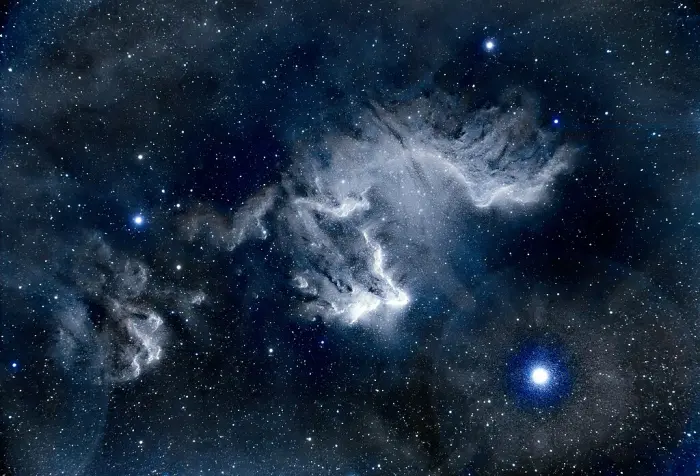
The Gamma Cas nebula gets its name from the bright star Gamma Cassiopeiae (aka Navi), observed in the bottom right quadrant in the image. It is part of the well-known W-shaped asterism in the Cassiopeia constellation and located 550 years from the solar system. The singular nebula actually consists of two distinctive emission nebulae, IC59/Sh2-185 (center and right) and IC63 (lower left). They are strikingly illuminated by the bright blue star. Image credit: Wikimedia Commons/Ram Samudrala (CC BY 4.0)
Gamma Cassiopeiae is an exceptionally fast spinner. It has a projected rotational velocity of 432 km/s. As a result, it has an equatorial bulge and expels material at a high rate. The material forms a hot circumstellar disk that causes variations in the star’s brightness.
Gamma Cassiopeiae was the first star to be classified as a Be star (a B-type star with emission lines). It is an eruptive variable star that serves as a prototype for a class of variable stars known as the Gamma Cassiopeiae variables. These are Be stars with a transient or variable disk that causes the stars’ brightness to vary. They are fast spinning stars with equatorial decretion disks which sometimes reform or disappear. The brightness of Gamma Cassiopeiae has been observed to vary between magnitude 3.0 and 1.6.
Other bright examples of this class include Dschubba (Delta Scorpii) in the constellation Scorpius, Zeta Ophiuchi in Ophiuchus, Kappa Canis Majoris in Canis Major, Gomeisa (Beta Canis Minoris) in Canis Minor, Lambda Pavonis in Pavo, and Pleione in the Pleiades cluster in Taurus.
Gamma Cassiopeiae is a known X-ray source. The amount of X-ray radiation that it emits is 10 times higher than that of other B or Be class stars.
In November 2025, Gamma Cassiopeiae was formally named Tiansi by the International Astronomical Union (IAU). The name is derived from Tiān Sì (Heavenly Quadriga, 天駟), the name of an ancient Chinese asterism associated with the legendary charioteer Wangliang.
In English literature, the star was sometimes referred to by the Chinese name Tsih (Cè), meaning “the whip.” However, the name originally applied to the blue supergiant Kappa Cassiopeiae and a version of it (Cexing) was approved for the fainter star in 2025.
Gamma Cassiopeiae is also known as Navi. The bright star was used by astronauts in navigation during space missions. American astronaut Virgin Ivan “Gus” Grissom nicknamed it Navi (Ivan backwards) as a practical joke. Grissom also named Talitha (Iota Ursae Majoris) Dnoces (“Second” backwards), after the Apollo 1 astronaut Edward H. White II, and Gamma Velorum Regor (“Roger” backwards), after his fellow astronaut Roger Chaffee.
Ruchbah – δ Cassiopeiae (Delta Cassiopeiae)
Ruchbah (δ Cas) is the fourth brightest star in Cassiopeia. It has an apparent magnitude of 2.68 and lies 99.4 light-years away.
Delta Cassiopeiae is an eclipsing binary star composed of a pair of stars that orbit each other with a period of 759 days. The eclipses cause the system’s brightness to drop by 0.07 magnitudes. Recent studies have found no variations of more than 0.01 magnitudes.
The eclipsing binary pair is part of a multiple star system listed as WDS J01258+6014 in the Washington Double Star Catalog.
The primary component in the system, formally known as Ruchbah, has a circumstellar debris disk at an orbital radius of 88 astronomical units (Earth – Sun distances). The star is a blue-white subgiant star of the spectral type A5 IV. It has a mass of 2.49 solar masses and a radius 3.90 times that of the Sun. With a surface temperature of 7,980 K, it is 72.88 times more luminous than the Sun.
Ruchbah is a fast spinner, with a projected rotational velocity of 123 km/s. It has an estimated age of 600 million years.
The name Ruchbah comes from the Arabic rukbah, meaning “the knee.” The star traditionally shared the name with Alpha Sagittarii in the constellation Sagittarius. The International Astronomical Union approved the name Rukbat for Alpha Sagittarii and Ruchbah for Delta Cassiopeiae in 2016.
Delta Cassiopeiae was also historically known as Ksora. The origin of the name is unknown. The name appeared in Czech astronomer Antonín Bečvář’s Skalnaté Pleso Atlas of the Heavens in 1951.
Segin – ε Cassiopeiae (Epsilon Cassiopeiae)
Segin (ε Cas) is a hot blue main sequence star of the spectral type B3 V. It lies 470 light-years from Earth and has an apparent magnitude of 3.37. It is the faintest and leftmost star of Cassiopeia’s W.
Segin has 9.2 times the Sun’s mass and a radius 6.10 times the Sun’s. With an effective temperature of 15,174 K, it shines with 3,059 solar luminosities. It has an estimated age of only 15.4 million years.
The star has a circumstellar shell of gas and shows the spectral properties of a Be star. It is a weak periodic variable. Its brightness changes by 0.0025 in magnitude at a rate of 11.17797 times per day.
The origin of the name Segin is uncertain. It is believed to have come from an erroneous transcription of the name Seginus, which applies to Gamma Boötis in the constellation Boötes.
Achird – η Cassiopeiae (Eta Cassiopeiae)
Achird (η Cas) is a Sun-like yellow dwarf located 19.32 light-years away. It is the nearest star to Earth in the constellation Cassiopeia. It appears in the region between Schedar and Gamma Cassiopeiae.
Achird shines at magnitude 3.44 and has the stellar classification G0 V. It forms a binary star system with an orange main sequence star of the spectral type K7 V. The stars have an orbital period of 480 years and are separated by 11.9939 arcseconds in the sky, corresponding to an average physical distance of 71 astronomical units (AU). The companion has an apparent magnitude of 7.50 and is invisible to the unaided eye.
Achird (Eta Cassiopeiae A), the primary component in the system, has 95% of the Sun’s mass and the same radius as the Sun. It shines with 1.23 solar luminosities and has a surface temperature of 6,010 K. The star is older than the Sun, with an estimated age of 5.4 billion years.
The orange dwarf Eta Cassiopeiae B is smaller and less massive. It has a mass of 0.57 solar masses and a radius of 0.66 solar radii. With an effective temperature of 4,036 K, it shines with 6.46% of the Sun’s luminosity.
The Eta Cassiopeiae system is classified as an RS Canum Venaticorum variable. RS CVn stars are close binary star systems with active chromospheres that cause large starspots. These stellar spots are responsible for causing the variations in brightness.
The origin of the name Achird is unknown. The name first appeared in the Skalnaté Pleso Atlas of the Heavens (Atlas Coeli Skalnaté Pleso 1950.0), a set of 16 star charts drawn by the Czech astronomer Antonín Bečvář at the Skalnaté Pleso Observatory in the Tatra Mountains in Slovakia.
Fulu – ζ Cassiopeiae (Zeta Cassiopeiae)
Fulu, Zeta Cassiopeiae (ζ Cas), is a hot blue subgiant star of the spectral type B2IV. It shines at magnitude 3.66 from a distance of 590 light-years and is the seventh brightest star in Cassiopeia.
The star has a mass 8.3 times that of the Sun and a radius 5.9 times solar. It is 5,500 times more luminous than the Sun and has an effective temperature of 20,426 K. It spins at about 17 km/s, taking 5.37045 days to complete a rotation.
Zeta Cassiopeiae is classified as a slowly pulsating B-type star (SPB). These variable stars pulsate with periods between half a day and five days. As they pulsate, both their brightness and their spectral line profiles change. However, they typically vary in brightness by less than 0.1 magnitudes. Bright examples of this class include Algenib and Homam in the constellation Pegasus, Omicron Velorum in Vela, and Tau and Iota Herculis in Hercules.
The name Fulu comes from the Chinese asterism called 附路 (Fùlù), meaning Auxiliary Road. In traditional Chinese astronomy, Zeta Cassiopeiae was the only star in the asterism. The International Astronomical Union (IAU) approved the name for the star in 2017.
ρ Cassiopeiae (Rho Cassiopeiae)
Rho Cassiopeiae (ρ Cas) is a yellow hypergiant of the spectral type G2Iae, located 8,150 light-years away. It appears in the same area as Caroline’s Rose Cluster (NGC 7789). With an apparent magnitude of 4.5, the star is visible to the unaided eye. It undergoes eruptions accompanied by dimming episodes about every 50 years. During these episodes, it dims to sixth magnitude.
Yellow hypergiants are very rare stars. They are luminous stars that start their lives with a mass 20 – 60 times that of the Sun and lose almost half of their initial mass when they evolve away from the main sequence. They are highly unstable pulsating stars with extended atmospheres and low surface gravities.
Only about 20 of these stars are known in the Milky Way, and six of them are members of the Ara Cluster (Westerlund 1) in the constellation Ara. Other than Rho and V509 Cassiopeiae, known yellow hypergiants include HR 5171A (V766 Centauri), V810 Centauri and Omicron1 Centauri in the constellation Centaurus, RW Cephei in Cepheus, R Puppis in Puppis, and V382 Carinae in Carina. Rho Cassiopeiae is the second brightest yellow hypergiant in the sky, after V382 Carinae.
Rho Cassiopeiae has a mass of 40 solar masses and a radius 564 – 700 times that of the Sun. With a surface temperature of 4,571 – 6,044 K, it is 302,000 – 530,000 times more luminous than the Sun.
The hypergiant star has an estimated age of only 4 – 6 million years. It is classified as a semiregular variable (type SRd). Semiregular variables are giant or supergiant stars of late spectral types that vary in brightness with noticeable periodicity. Other SRd variables include Omicron1 Centauri and V810 Centauri in Centaurus, Z Ursae Majoris in Ursa Major, RR Ursae Minoris in Ursa Minor, and V509 Cassiopeiae in Cassiopeia.
V509 Cassiopeiae
V509 Cassiopeiae (V509 Cas) is a yellow hypergiant located approximately 12,400 light-years away. It has an apparent magnitude of 4.6 and an absolute magnitude of -8.6. It is faintly visible to the unaided eye in good conditions. The star appears near the border with Cepheus, in the same area as the Wizard Nebula (NGC 7380).
V509 Cassiopeiae has the stellar classification of G0Ia0. It has a mass 10.6 times that of the Sun and has grown to a size of 511 solar radii as it evolved away from the main sequence. With an effective temperature in the range between 5,000 and 5,300 K, it shines with 269,000 solar luminosities.
The enormous star is believed to have had 25 times the Sun’s mass when it was on the main sequence. It has lost most of it through a powerful stellar wind as it expanded into a supergiant. The star’s initial mass seals its fate as a supernova in the not-too-distant future (astronomically speaking). Before it goes out, the hypergiant is likely to evolve into a luminous blue variable and then into a Wolf-Rayet star.
Like other evolved, unstable stars, V509 Cas is varying in brightness, temperature and size. It is currently evolving from cooler to hotter temperatures.
Like its Cassiopeia neighbour Rho Cassiopeiae, the yellow-white star is classified as a semiregular variable (type SRd). Its brightness has been observed to vary from below magnitude 6 to as bright as magnitude 4.6.
Cexing – κ Cassiopeiae (Kappa Cassiopeiae)
Kappa Cassiopeiae (κ Cas) is a hot blue supergiant star of the spectral type BC0.7 Ia, located approximately 4,000 light-years away. It is classified as an Alpha Cygni variable. Its brightness varies from magnitude 4.12 to 4.21 due to pulsations.
The supergiant has a mass 33 times that of the Sun and a radius 39 times solar. With a surface temperature of 24,600 K, it is 490,000 times more luminous than the Sun. It has an estimated age of only 4.5 million years. Despite its young age, the massive star will soon reach the end of its life. Its high mass seals its fate as a supernova in the relatively near future.
Kappa Cassiopeiae is believed to be a member of the Cassiopeia OB14 association. It is a runaway star. It creates a bow shock 12 light-years long and 1.8 light-years wide as it travels through the interstellar medium.
In November 2025, the International Astronomical Union officially approved the name Cexing for the star. In Chinese astronomy, Kappa Cassiopeiae represented the whip of the legendary charioteer Wáng Liáng. Cè means “whip” and xing is Chinese for “star.”
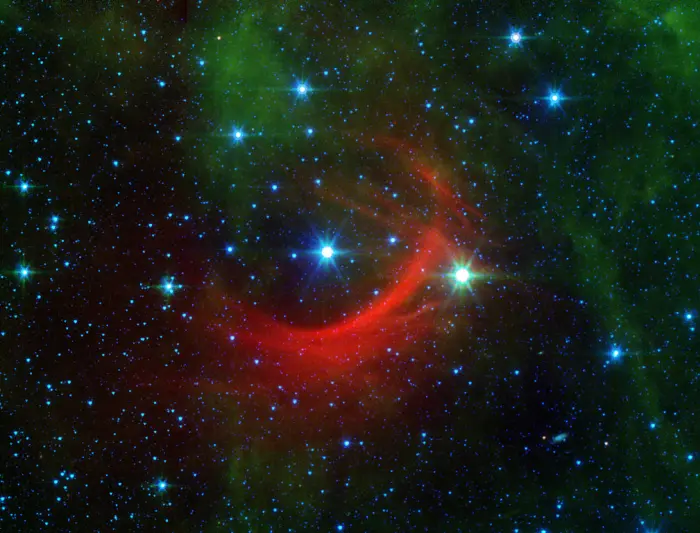
Kappa Cassiopeiae, or HD 2905 to astronomers, is a runaway star—a massive, hot supergiant gone rogue. What really makes the star stand out in this image is the surrounding, streaky red glow of material in its path. Such structures are called bow shocks, and they can often be seen in front of the fastest, most massive stars in the galaxy. Bow shocks form where the magnetic fields and wind of particles flowing off a star collide with the diffuse, and usually invisible, gas and dust that fill the space between stars. How these shocks light up tells astronomers about the conditions around the star and in space. Slow-moving stars like our sun have bow shocks that are nearly invisible at all wavelengths of light, but fast stars like Kappa Cassiopeiae create shocks that can be seen by Spitzer’s infrared detectors. Incredibly, this shock is created about 4 light-years ahead of Kappa Cassiopeiae, showing what a sizable impact this star has on its surroundings. Image credit: NASA/JPL-Caltech (PD)
Castula – υ2 Cassiopeiae (Upsilon2 Cassiopeiae)
Castula (υ2 Cas) is a yellow giant star of the spectral type G8 IIIb Fe-0.5. It shines at magnitude 4.62 from a distance of 189 light years. It appears a few degrees south of Gamma Cassiopeiae, the central star of Cassiopeia’s W.
Castula has a mass of 1.44 solar masses and a radius 10.44 times that of the Sun. With an effective temperature of 4,937 K, it is 55.3 times more luminous than the Sun. It has an estimated age of 2.2 billion years.
The name Castula is the Latin word for “petticoat.”
Nushagak – HD 17156
HD 17156 is a yellow subgiant star located 255.3 light-years from the Sun. With an apparent magnitude of 8.17, it is invisible to the unaided eye. It was the first star in Cassiopeia discovered to host an orbiting planet, a hot Jupiter.
HD 17156 has a mass of 1.275 solar masses and a radius of 1.5007 solar radii. It has a surface temperature of 6,079 K and an estimated age of 3.37 billion years.
The star was named Nushagak, after a river in Alaska, during the 2019 NameExoWorlds campaign. The planet HD 17156 b was named Mulchatna, after a tributary of the Nushagak river.
HD 17156 b was discovered in April 2007 using the radial velocity method. It has a mass of 3.235 Jupiter masses and orbits the parent star with a period of 21.2163979 days at an orbital separation of 0.16278 astronomical units (16% of the distance between the Earth and the Sun).
6 Cassiopeiae
6 Cassiopeiae is a white hypergiant star of the spectral type A2.5 Ia, located 8,187 light-years away. With a mass 22 times that of the Sun, it is a supernova candidate. It has a radius 193 times that of the Sun and spins at 50 km/s. With an effective temperature of 10,023 K, 6 Cas shines with 200,000 solar luminosities.
The hypergiant is classified as an Alpha Cygni variable and has the variable star designation V566 Cassiopeiae. Like Deneb (Alpha Cygni) in the constellation Cygnus, it varies in brightness due to non-radial pulsations. Its brightness varies from magnitude 5.34 to 5.45.
Gliese 892 (HD 219134)
Gliese 892 is an orange main sequence star of the spectral type K3V. It lies 21.336 light-years away and has an apparent magnitude of 5.574. The star hosts a system of six known exoplanets. None of them orbit in the star’s habitable zone.
HD 219134 is smaller and less massive than the Sun. It has a mass of 0.81 solar masses and a radius 77.8% that of the Sun. With a surface temperature of 4,699 K, it shines with 26.46% of the Sun’s luminosity. The orange dwarf is a very old star, with an estimated age of 11 billion years.
The planets in the Gliese 892 system are all at least 4 times more massive than Earth. Two of them – HD 216134 b and c – are rocky super-Earths.
Pearce’s Star – AO Cassiopeiae
AO Cassiopeiae (AO Cas) is a massive binary star located approximately 2,400 light-years away. The star is composed of a hot blue main sequence star of the spectral type O8V((f)) and a blue bright giant with the stellar classification O9.2II.
The two components orbit each other with a period of 3.52348 days at a distance of 28.57 solar radii. They form an eclipsing binary star. As the two stars orbit and periodically eclipse each other, the system’s brightness varies with a period that corresponds to its orbital period. The system’s brightness varies from magnitude 6.07 to 6.24, making the system theoretically visible to the unaided eye in exceptionally good conditions.
The two components of the AO Cassiopeiae system form a contact binary star. They are so close together that they share their gaseous envelope and their shapes have been distorted into ellipses by mutual gravitational forces. Both stars are supernova candidates, with masses of 9.65 and 15.59 solar masses.
AO Cassiopeiae was named Pearce’s Star after the Canadian astrophysicist Joseph Algernon Pearce, who investigated the massive star system in 1924-25.
HD 15558
HD 15558 is a massive hot blue multiple star system located approximately 5,700 light-years away. The system is a member of the open cluster IC 1805 in the Heart Nebula.
The primary component is an exceptionally massive star. It is a giant of the spectral type O4.5 with an estimated mass of 152 solar masses. It has a radius 16.4 times that of the Sun and shines with around 660,000 solar luminosities with an effective temperature of 39,500 K. The star has an estimated age of only 0.7 – 3 million years. It is part of a spectroscopic binary system.
The secondary component is also a supernova candidate. It is a main sequence star of the spectral type O7V. It has 46 times the Sun’s mass and a radius 5.6 times solar.
The two components orbit each other with a period of 442 days at a distance of 726 solar radii.
HD 7924
HD 7924 is an orange main sequence star of the spectral type K0.5V. It has an apparent magnitude of 7.167 and lies 55.45 light-years away. It appears near the border with the constellation Cepheus. The star will make its closest approach to the Sun in around 711,700 years, when it comes within 9.3 light-years.
The orange dwarf has 81% of the Sun’s mass and 74% its radius. With an effective temperature of 5,216 K, it shines with 36.4% of the Sun’s luminosity. It has an estimated age of 3 billion years.
HD 7924 hosts a system of three planets. The first one, a super-Earth, was discovered in 2009, followed by two more super-Earths in 2015. All three planets orbit within the star’s habitable zone.
HD 7924 b, the innermost planet, has 8.68 times the Earth’s mass and orbits the host star with a period of 5.39792 days at a distance of 0.05664 astronomical units. HD 7924 c and HD 7924 d are less massive, with masses of 7.86 and 6.44 Earth masses. They have orbital periods of 15.299 and 24.451 days and semimajor axes of 0.1134 and 0.1551 AU.
S Cassiopeiae
S Cassiopeiae is an S-type star located approximately 3,100 light-years away. S-type stars are cool giant stars with equal amounts of carbon and oxygen in their atmospheres.
With an effective temperature of only 1,800 K, S Cas is an unusually cool star. It is surrounded by dense clouds of dust and gas. The star is experiencing considerable mass loss through a strong stellar wind. It is losing 1.8 x 10-6 solar masses per year.
S Cassiopeiae has a radius 934 times that of the Sun. It if replaced the Sun at the centre of our solar system, it would engulf Mars and the Asteroid Belt. The star shines with a luminosity of 5,210 Suns.
The brightness of S Cassiopeiae varies between magnitude 7.9 and 16.1 with a period of 612.43 days. The star is classified as a Mira variable. Mira variables are pulsating stars in a late stage of their evolutionary cycle. They are unstable stars that will soon expel their outer envelopes to form planetary nebulae. The pulsations cause a change in their radius, temperature and luminosity.
PZ Cassiopeiae
PZ Cassiopeiae is a red supergiant located 9,160 light-years away. It appears in the same area of the sky as 6 Cassiopeiae. With an apparent magnitude that varies between 8.2 and 10.2, the star shines well below unaided eye visibility. It is one of the largest stars known, as well as one of the most luminous known red supergiants.
PZ Cassiopeiae had an initial mass of 20 to 25 solar masses. It has an estimated radius of 1,259 to 1,336 solar radii and shines with 229,000 solar luminosities. It has an effective temperature of 3,605 K. The supergiant star is believed to be only 8 -10 million years old.
PZ Cas is classified as a semiregular variable star. It has a 13th magnitude companion, a Cepheid variable, at a separation of 12 arcseconds.
TZ Cassiopeiae
TZ Cassiopeiae is a red supergiant located approximately 8,400 light-years away. With an apparent magnitude of 9.18, it is invisible to the unaided eye.
The star has a mass of 4.9 solar masses and has expanded to a size of 767 solar radii as it evolved away from the main sequence. With a surface temperature of 3,597 K, it is 97,275 times more luminous than the Sun.
TZ Cassiopeiae has lost much of its initial mass through a strong stellar wind. The star’s initial mass has been estimated to be around 15 solar masses, which makes TZ Cas a supernova candidate.
TZ Cassiopeiae is classified as a slow irregular variable (type Lc). Like PZ Cassiopeiae, it is a member of the Cassiopeia OB5 stellar association.
WR 2
WR 2 is a Wolf-Rayet star of the spectral type WN2-w located approximately 8,187 light-years away. It appears in the region near Gamma Cassiopeiae. With an apparent magnitude of 11.33, the massive star is invisible to the unaided eye. With a radius of only 0.89 solar radii, it is smallest WN star known in our galaxy.
WR 2 is an exceptionally fast spinner. It spins at 500 km/s or possibly even faster, close to its breakup velocity.
The star has 16 times the Sun’s mass and is a supernova candidate. With a surface temperature of 141,000 K, it is 282,000 times more luminous than the Sun. When it goes out as a supernova, it will likely produce a gamma-ray burst. The star has an estimated age of only 4 million years.
Deep sky objects in Cassiopeia
Cassiopeia hosts many bright star clusters and nebulae that are visible in small and medium telescopes. It contains two Messier objects – the open clusters Messier 52 (NGC 7654, the Scorpion Cluster) and Messier 103 (NGC 581) – and six objects listed in the Caldwell catalogue: the open clusters NGC 559 (Caldwell 8), NGC 663 (Caldwell 10), NGC 457 (Caldwell 13, the Owl Cluster or the E. T. Cluster), the emission nebula NGC 7635 (Caldwell 11, the Bubble Nebula), and the dwarf spheroidal galaxies NGC 147 (Caldwell 17) and NGC 185 (Caldwell 18).
The constellation is home to 16 deep sky objects listed in the Herschel 400 catalogue. Like the Messier and Caldwell objects, those on the Herschel 400 observing list can be seen in amateur telescopes. In addition to the galaxy NGC 185 and the open clusters NGC 457, NGC 559, and NGC 663, these are the open clusters NGC 129, NGC 136, NGC 225, NGC 381, NGC 436, NGC 637, NGC 654, NGC 659, NGC 1027, NGC 7789 (Caroline’s Rose Cluster), and NGC 7790, and the galaxy NGC 278.
Messier 52 (NGC 7654)
Messier 52 (M52) is a bright open cluster located approximately 4,600 light-years away. With an apparent magnitude of 7.3 and an apparent size of 13 arcminutes, it is visible in binoculars in good conditions. The cluster appears near the border with the constellation Cepheus, in the same region as the Bubble Nebula. It is sometimes known as the Scorpion Cluster.
Messier 52 has a radius of 9.5 light years and a mass of 1,200 solar masses. It has a core radius of 2.97 light-years and a tidal radius that stretches for 42.7 light-years.
The bright cluster has an estimated age of 158.5 million years. It was discovered by the French astronomer and comet hunter Charles Messier on September 7, 1774.
Messier 52 can be found by extending a line from Schedar through Caph, the rightmost stars of Cassiopeia’s W, in the direction of Alderamin, the brightest star in Cepheus.
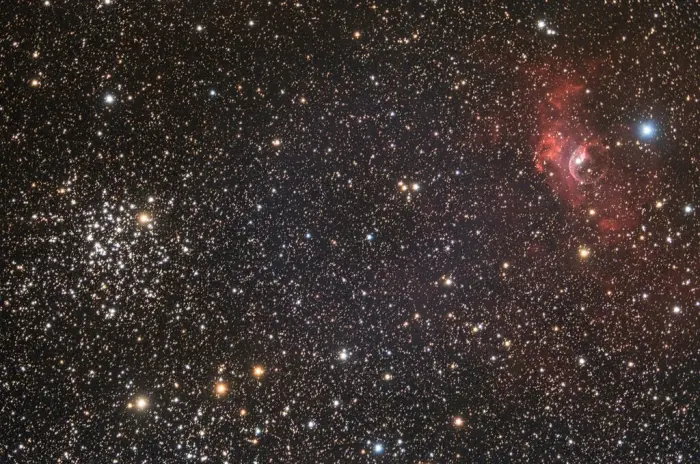
Messier 52 (left) and the Bubble Nebula (right), image: Radan Mitroviќ (CC BY-SA 4.0)
Messier 103 (NGC 581)
Messier 103 (M103) is an open star cluster with an apparent magnitude of 7.4, located approximately 9,400 light-years away. It appears in the region of Cassiopeia’s W, between Ruchbah and Segin (the leftmost stars of the W).
Messier 103 has an apparent size of 6 arcminutes and can be seen in binoculars and modest telescopes. It was discovered by the French astronomer Pierre Méchain on March 27, 1781. Charles Messier listed it as the last object in his catalogue. (The final seven Messier objects were added by other astronomers based on Messier’s and Méchain’s observations.)
The M103 cluster is around 15 light-years across. Its brightest members shine at magnitudes 10.5 and 10.8. The cluster has about 172 stars that are likely members. The estimated age of M103 is between 12.6 and 25 million years.
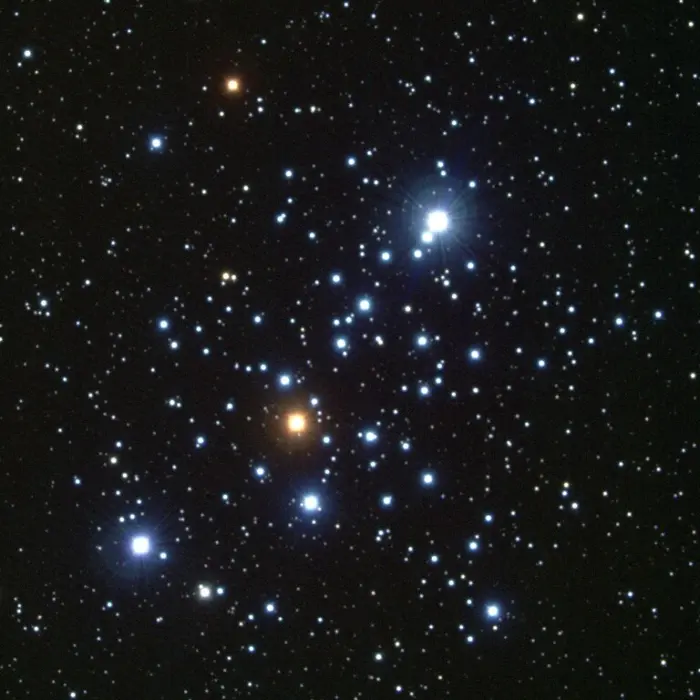
The irregular star cluster M103, or NGC 581, is a distant cluster in the constellation Cassiopeia. One of the more remote open clusters, M103s relatively small angular size still corresponds to a sizable 14 light-year diameter (this image is only 8.6 arc minutes across). The bright binary (upper right, NW) is not part of the cluster. Image credit: Hillary Mathis, N.A.Sharp/NOIRLab/NSF/AURA (CC BY 4.0)
Bubble Nebula (NGC 7635)
The Bubble Nebula (NGC 7635, C11) is a large emission nebula located between 7,100 and 11,000 light-years away. The H II region appears near the border with Cepheus, in the same area as Messier 52. It has an apparent magnitude of 10 and an apparent size of 15 by 8 arcminutes. Depending on the distance, the nebula has a radius of 3 to 5 light-years. It is also catalogued as Sharpless 162 (Sh2-162).
The bubble that gives NGC 7635 its name is created by the strong stellar wind of the central star SAO 20575 (BD+60°2522). The wind has a velocity of 1,800 to 2,500 km/s and is responsible for the star’s high mass loss rate.
The expansion of the bubble is contained by a nearby molecular cloud. Like the Bubble Nebula, the giant cloud is excited and made luminous by the hot star SAO 20575.
SAO 20575 is an exceptionally massive and luminous blue star of the spectral type O6.5. It shines at magnitude 8.67 from a distance of 9,800 light-years. It has a mass 44 times that of the Sun and a radius 15 times solar.
With an effective temperature of 37,500 K, the star is 398,000 times more luminous than the Sun. It is an exceptionally fast spinner, with a projected rotational velocity of 178 – 240 km/s. It has an estimated age of only 2 million years, while the Bubble Nebula is believed to be 40,000 years old.
The Bubble Nebula was discovered by the German-born British astronomer Sir William Herschel on November 3, 1787. It is best seen in 10-inch and larger telescopes using averted vision because a nearby 7th magnitude star can overwhelm the eye.
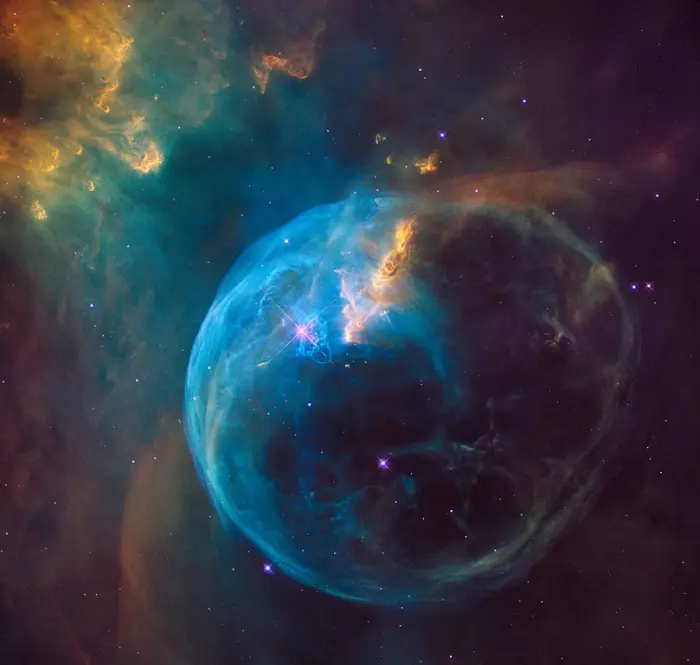
For the 26th birthday of NASA’s Hubble Space Telescope, astronomers are highlighting a Hubble image of an enormous bubble being blown into space by a super-hot, massive star. The Hubble image of the Bubble Nebula, or NGC 7635, was chosen to mark the 26th anniversary of the launch of Hubble into Earth orbit by the STS-31 space shuttle crew on April 24, 1990. Image credit: NASA, ESA, and the Hubble Heritage Team (STScI/AURA) (PD)
Owl Cluster (E.T. Cluster) – NGC 457 (Caldwell 13)
The Owl Cluster (NGC 457) is a bright open cluster located 7,922 light-years away. With an apparent magnitude of 6.5 and an apparent size of 13 arcminutes, it can be seen with binoculars and small telescopes, even in less-than-ideal conditions. Its brightest members are 9th magnitude stars.
The cluster was discovered by William Herschel on August 18, 1780. Its distinctive appearance has earned it the nicknames the Owl Cluster, the E.T. Cluster, and the Dragonfly Cluster.
The cluster is sometimes also called the Phi Cassiopeiae Cluster because the multiple star Phi Cassiopeiae is the brightest star in the same field of view. Phi Cassiopeiae marks one of the owl’s eyes, but may not be a member of NGC 457. Recent distance estimates place it approximately 15,000 light-years away.
The open cluster appears near Ruchbah, in the same region as the faint planetary nebula Sh2-188, popularly known as the Dolphin Nebula or the Shrimp Nebula.
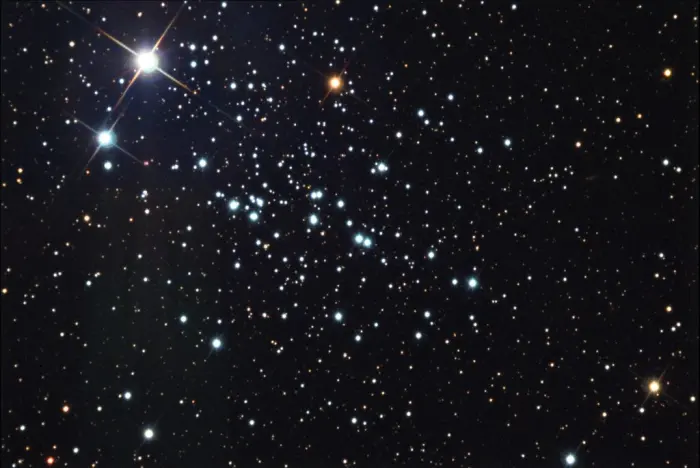
The Owl Cluster (NGC 457), image credit: KPNO/NOIRLab/NSF/AURA/Ken and Emilie Siarkiewicz/Adam Block (CC BY 4.0)
Cassiopeia A
Cassiopeia A is a supernova remnant located approximately 11,000 light-years away in the Perseus Arm of the Milky Way. The expanding cloud of material ejected in the supernova event is now around 10 light-years across. The light from the supernova first reached Earth around the 1690s, but there are no records of the event.
Cassiopeia A is the remnant of a Type IIb supernova, triggered by the rapid collapse of a star with a mass at least 8-9 times that of the Sun. It is the strongest radio source in the sky beyond the solar system and one of the first radio sources discovered. The supernova is believed to have peaked at magnitude 6. It appears in the same region as the open cluster Messier 52 and the Bubble Nebula.
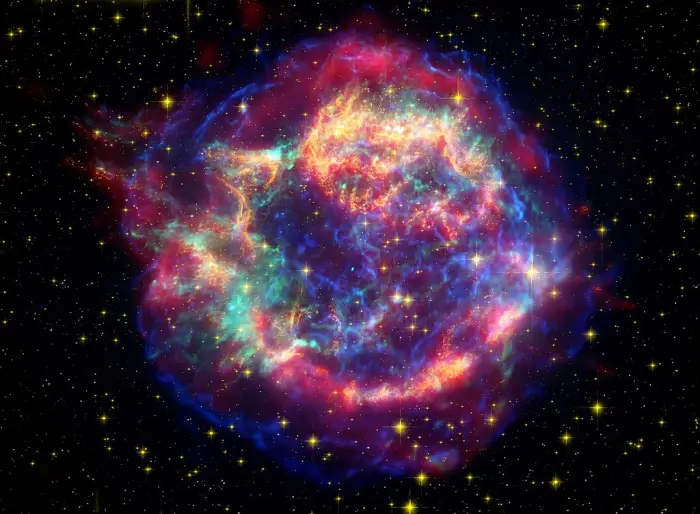
This stunning false-color picture shows off the many sides of the supernova remnant Cassiopeia A. It is made up of images taken by three of NASA’s Great Observatories, using three different wavebands of light. Infrared data from the Spitzer Space Telescope are colored red; visible data from the Hubble Space Telescope are yellow; and X-ray data from the Chandra X-ray Observatory are green and blue. Image: NASA/JPL-Caltech/STScI/CXC/SAO Animation: NASA/JPL-Caltech/Univ. of Ariz./STScI/CXC/SAO (PD)
The supernova remnant is expanding at a rate of 4,000 to 6,000 km/s and has a temperature of about 30 million K. It is not expanding uniformly; high velocity knots are moving at velocities of 5,500 to 14,500 km/s. The highest speeds have been detected in the opposing jets.
The stellar remnant was discovered as a discrete astronomical radio source by the British astronomers Martin Ryle and Francis Graham-Smith in 1947. The optical component of the remnant was found in 1950. The remnant of the progenitor star was detected by the Chandra X-ray Observatory in 1999. The neutron star is catalogued as CXOU J232327.8+584842.
Cassiopeia A is a challenging target for amateur telescopes, but it has been spotted in 10-inch and larger telescopes in good conditions.
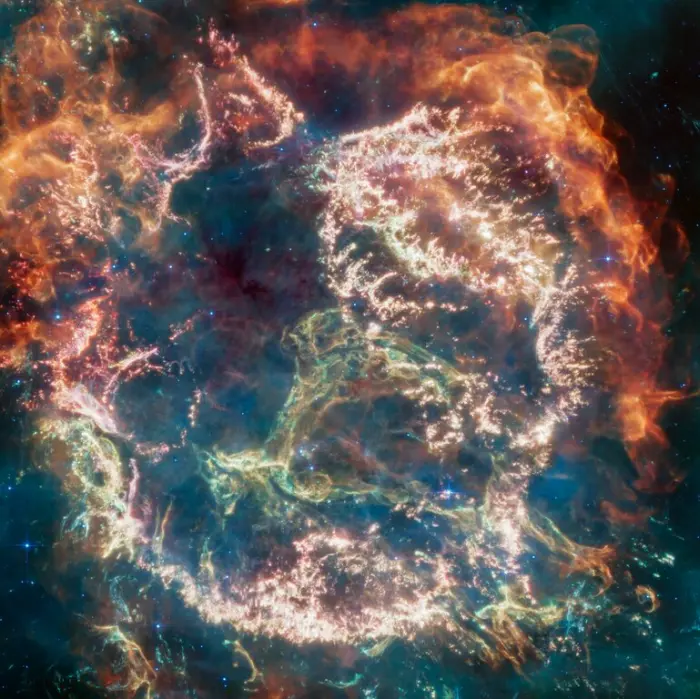
Cassiopeia A by the James Webb Space Telescope (JWST). This image, released in April 2023, uses data from Webb’s Mid-Infrared Instrument (MIRI) to reveal Cas A in a new light. On the remnant’s exterior, particularly at the top and left, lie curtains of material, appearing orange and red, that are due to emission from warm dust. This marks where ejected material from the progenitor star is ramming into surrounding circumstellar material. Interior to this outer shell lie mottled filaments of bright pink studded with clumps and knots. This is material from the star itself, and likely shines due to a mix of various heavy elements and dust emission. The stellar material can also be seen as fainter wisps near the cavity’s interior. A loop represented in green extends across the right side of the central cavity. Its shape and complexity are unexpected and challenging for scientists to understand. Image credit: NASA, ESA, CSA, D. Milisavljevic (Purdue University), T. Temim (Princeton University), I. De Looze (UGent), J. DePasquale (STScI) (CC BY 4.0)
Pacman Nebula (NGC 281)
The Pacman Nebula (NGC 281) is an emission nebula within a larger H II region located approximately 9,500 light-years away. The nebula lies in the Perseus Arm of the Milky Way galaxy and appears in the region of Cassiopeia’s W, near Schedar (Alpha Cas). It has an apparent size of 35 arcminutes.
NGC 281 was discovered by the American astronomer Edward Emerson Barnard on November 16, 1881. The nebula is about 96 light-years across. It is energized by the young stars in the open cluster IC 1590.
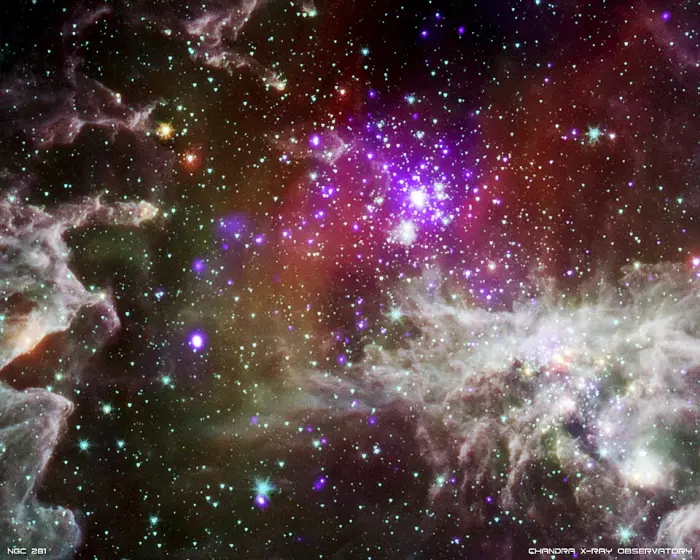
This composite image of NGC 281 contains X-ray data from Chandra, in purple, with infrared observations from Spitzer, in red, green, blue. NGC 281 is typically divided into two subregions: the region in the upper middle of the image, which is surrounded by the purple 10-million-degree gas, and a younger region in the lower part of the image. There is evidence that the formation of a cluster, appearing in a beige cloud to the lower right, was triggered by a previous generation of star formation. Also, astronomers have found some isolated star formation on the left side of the image that appears to have been occurring at the same time as star formation in other regions of the cluster. This supports the idea that something externally triggered the “baby boom” of stars in NGC 281. Image credit – X-ray: NASA/CXC/CfA/S.Wolk; IR: NASA/JPL/CfA/S.Wolk (PD)
The cluster has an estimated age of only 3.5 million years. It is embedded in NGC 281 and has an apparent magnitude of 7.4.
NGC 281 has been nicknamed the Pacman Nebula because its shape resembles the popular 1980s video game character. The nebula can be spotted in small telescopes in good conditions.
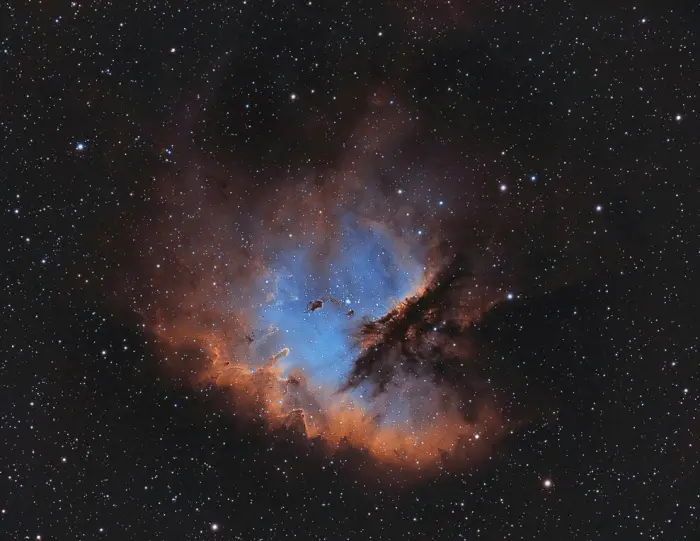
Pacman Nebula (NGC 281), image: Chuck Ayoub (CC BY-SA 4.0)
Tycho’s Supernova (SN 1572)
Tycho’s Supernova is the remnant of a Type Ia supernova that was observed in early November 1572. It is also known as Tycho’s Nova or B Cassiopeiae, and has the radio source designation 3C 10. The remnant lies between 8,000 and 9,800 light-years away. The progenitor star is unknown.
The supernova SN 1572 peaked at magnitude -4, which is comparable to the mean brightness of the planet Venus. It stayed visible to the unaided eye until early 1574.
The remnant was named Tycho’s Supernova after the Danish astronomer Tycho Brahe, who published an extensive work on it, called De nova et nullius aevi memoria prius visa stella (“Concerning the Star, new and never before seen in the life or memory of anyone”) in 1573.
Tycho G, a subgiant star located approximately 6,400 light-years away, has been proposed as the progenitor’s binary companion. The yellow subgiant star is moving away from us at 79.22 km/s, which is much faster than the average velocity of other stars in the vicinity. The star’s properties have led some astronomers to propose it as the surviving companion of the supernova progenitor, but other studies have excluded it.
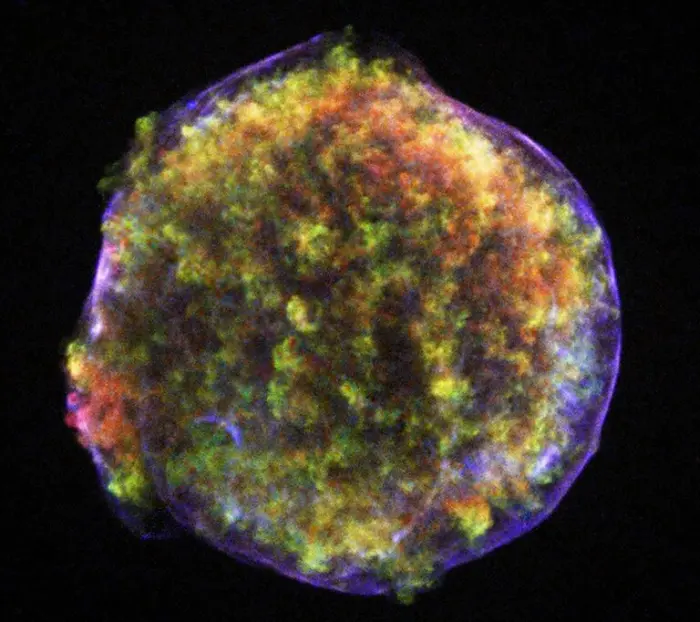
In 1572, the Danish astronomer Tycho Brahe observed and studied the dramatic end of a star that became known as Tycho’s supernova. More than four centuries later, Chandra’s image of the supernova remnant shows an expanding bubble of multimillion degree debris (green and red) inside a more rapidly moving shell of high energy electrons (filamentary blue). Image credit: NASA/CXC/Rutgers/J.Warren & J.Hughes et al. (PD)
Heart Nebula (Sharpless 2-190)
The Heart Nebula (Sh2-190) is a vast emission nebula located 7,500 light-years away in the Perseus Arm of the Milky Way. It has an apparent magnitude of 18.3 and an apparent size of 150 arcminutes, almost equivalent to four full Moons. The nebula is associated with the open cluster IC 1805 and forms a pair with the neighbouring Soul Nebula (Westerhout 5), which lies to the east.
The Heart Nebula was discovered by William Herschel on November 3, 1787. It has a physical radius of 165 light years. The young open cluster within the nebula contains several stars with almost 50 times the Sun’s mass and many fainter stars less massive than the Sun. The stellar winds from the hot young stars in the nebula are responsible for sculpting the nebular gas.
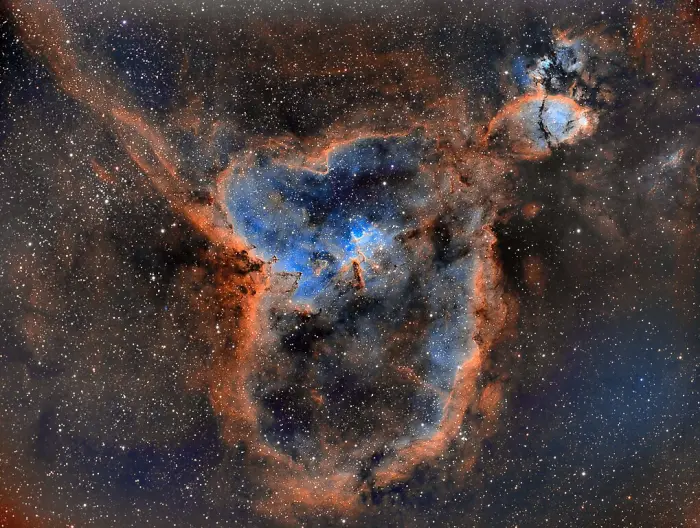
The Heart Nebula and the Fish Head Nebula, image: Wikimedia Commons/Ram Samudrala (CC BY 4.0)
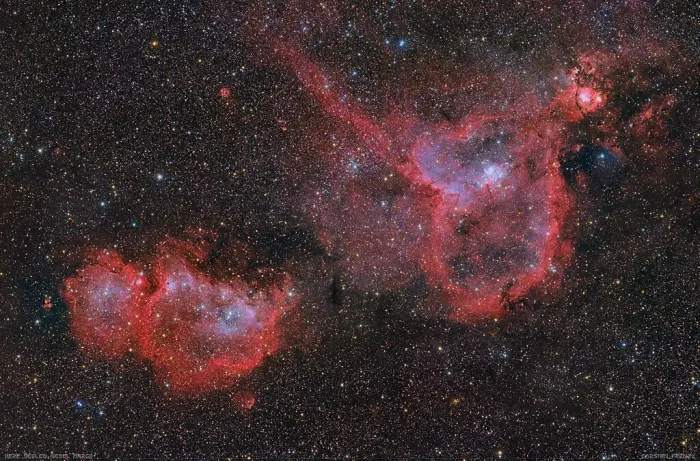
The Heart and Soul nebulae, image credit: Carsten Frenzl (CC BY 2.0)
Soul Nebula (Sharpless 2-199)
The Soul Nebula (Westerhout 5, Sh2-199) is a large emission nebula located 7,500 light-years away. Like the nearby Heart Nebula, it has a very low surface brightness and is a difficult target in amateur telescopes. The Heart and Soul nebulae are both best seen photographically.
The Soul Nebula has an apparent size of 150 by 75 arcminutes and a linear radius of 165 light-years. It contains several young open star clusters, catalogued as IC 1848, CR 34, CR 632, and CR 634. The nebula is often referred to by the star cluster designation IC 1848.
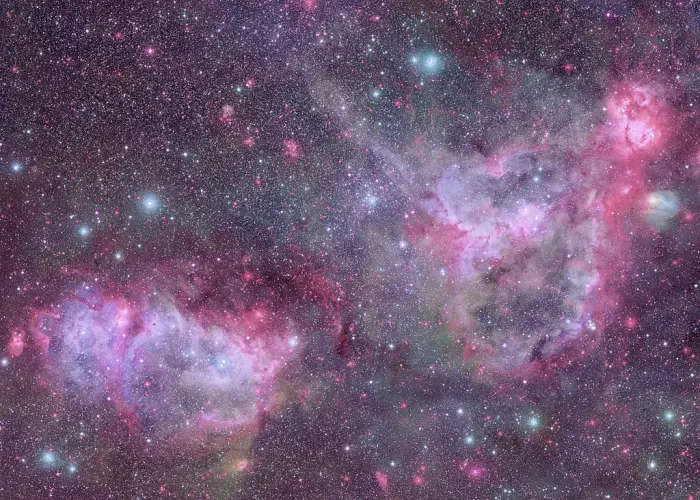
The Soul Nebula (left) and the Heart Nebula (right), image credit: Giuseppe Donatiello (CC0 1.0)
Sharpless 2-201 (Sh2-201)
Sh2-201 is an emission nebula that appears along the eastern border of the larger Soul Nebula (IC 1848). The nebula lies approximately 9,980 light-years away. It has an apparent size of 5 by 5 arcminutes.
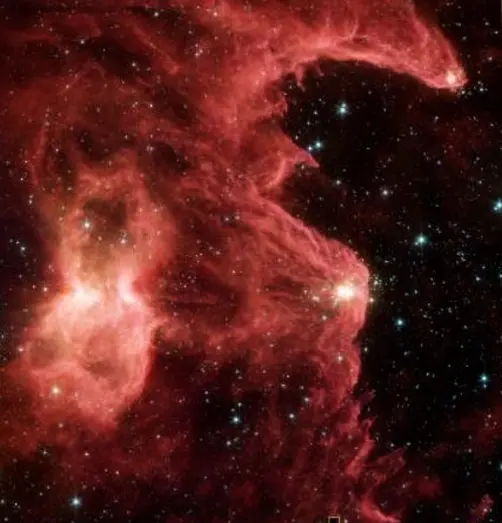
Sh2-201 by the Hubble Space Telescope, image credit: NASA/ESA/Hubble (CC BY-SA 4.0)
Fish Head Nebula (IC 1795)
The Fish Head Nebula (IC 1795) is a large star forming region located approximately 6,000 light-years away in the Perseus Arm of the Milky Way galaxy. It has an apparent size of 3.1 arcminutes. It is sometimes also known as the Northern Bear Nebula.
IC 1795 appears next to the larger Heart Nebula (Sh2-190). The HII region hosts hot young stars whose ultraviolet light is responsible for exciting the nebular gas and making it glow. The brighter part of the Fish Head Nebula is catalogued as NGC 896 and Minkowski 2-57 (Min 2-57). It contains numerous massive young stars.
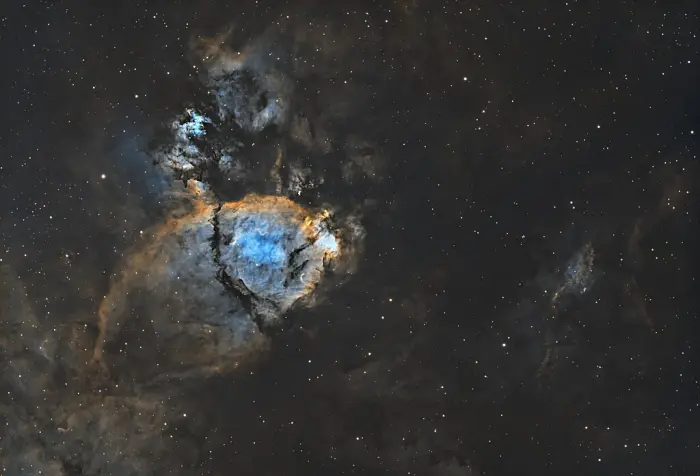
The Fish Head Nebula (IC 1795), image: Wikimedia Commons/Astrophoto Andy (CC0 1.0)
Caroline’s Rose Cluster (NGC 7789)
NGC 7789 is an open star cluster located approximately 7,600 light-years away. With an apparent magnitude of 6.7 and an apparent size of 16 arcminutes, it is easily visible in binoculars and small telescopes. It has an estimated age of 1.7 billion years and a mass of 6,620.4 Suns.
The cluster is known as Caroline’s Rose Cluster, Caroline’s Haystack, or the White Rose Cluster. The names refer to the loops of stars that resemble the pattern of rose petals. NGC 7789 was discovered by Caroline Herschel on November 1, 1783 and catalogued by her brother William Herschel as H VI.30.
The cluster is also known as the Ghost Cluster, the Screaming Skull Cluster, the Crab Cluster, the Star Mist Cluster, and Herschel’s Spiral Cluster. It appears roughly halfway between Rho and Sigma Cassiopeiae.
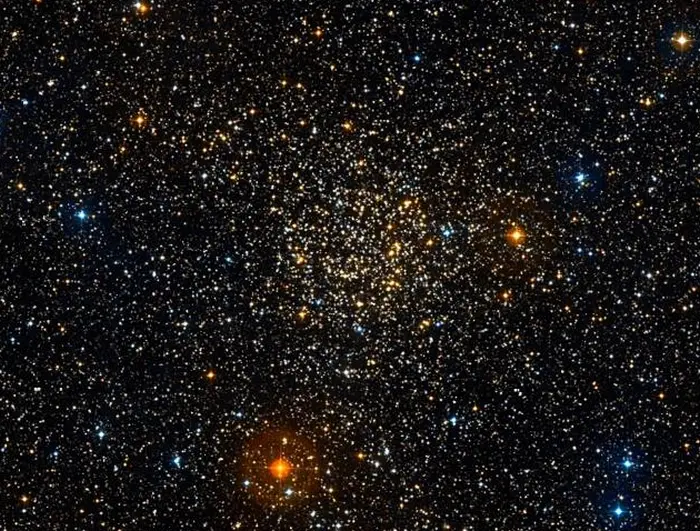
Caroline’s Rose Cluster (NGC 7789), image: Wikisky (DSS)
Ghost’s Goblet – NGC 559 (Caldwell 8)
NGC 559 (C8) is an open cluster located 7,200 light-years away. It is sometimes called the Ghost’s Goblet. It was discovered by William Herschel on November 9, 1787.
The cluster has an apparent visual magnitude of 9.5 and an apparent size of 7 minutes of arc. It has an estimated age of 1.8 billion years.
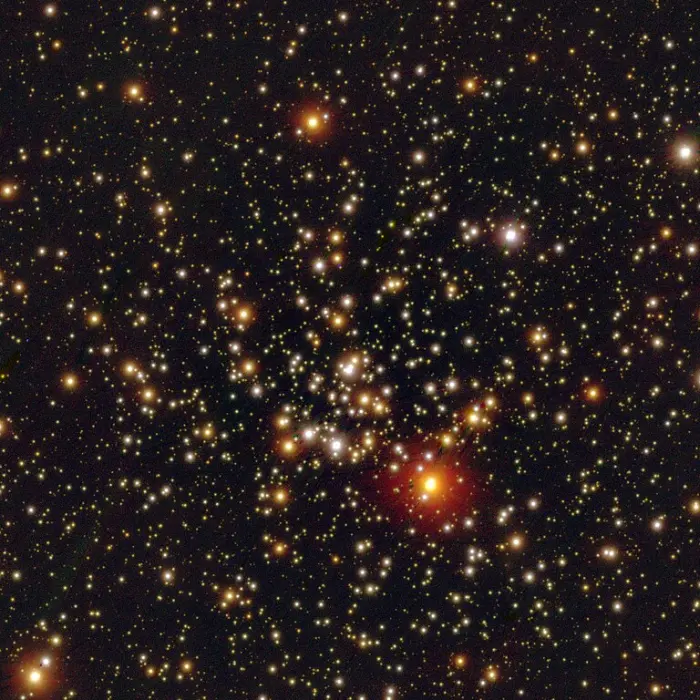
NGC 559, image: PanSTARRS (CC BY-SA 4.0)
Lawnmower Cluster – NGC 663 (Caldwell 10)
NGC 663 (C10) is an open star cluster with an apparent magnitude of 7.1 and an apparent size of 16 arcminutes. It lies 6,850 light-years away in the Perseus Arm of the Milky Way and appears in the region between Segin and Ruchbah. It has an estimated age of 20 – 25 million years.
The cluster contains around 400 stars. The brightest ones can be resolved in binoculars. They are members of the Cassiopeia OB8 association.
NGC 663 was discovered by Caroline Herschel on September 27, 1783. It is sometimes called the Lawnmower Cluster or the Letter S Cluster.
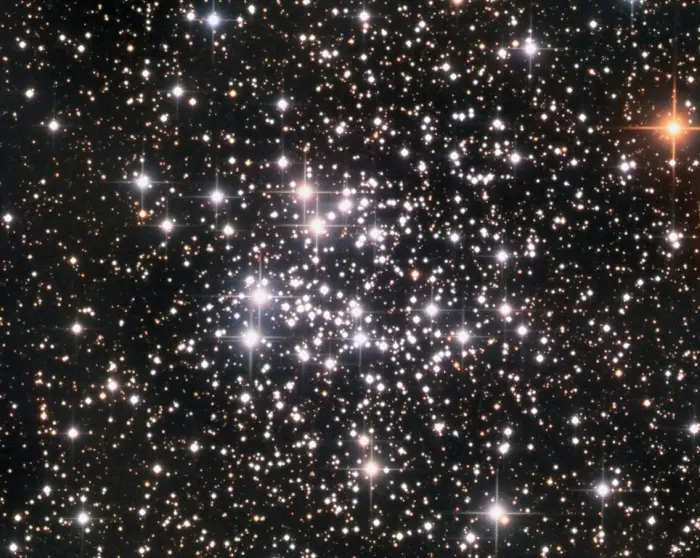
NGC 663, image: Wikimedia Commons/SeanXCurry (CC BY-SA 4.0)
NGC 147 (Caldwell 17)
NGC 147 (C17) is a dwarf spheroidal galaxy located approximately 2.53 million light-years away. It has an apparent magnitude of 10.5 and an apparent size of 13.2 by 7.8 arcminutes. It is a satellite of the Andromeda Galaxy (Messier 31) and forms a physical pair with the fellow dwarf spheroidal galaxy NGC 185 (C18). Both galaxies are members of the Local Group of galaxies.
NGC 147 was discovered by the British astronomer John Herschel on September 8, 1829. Unlike NGC 185, which can be spotted in small telescopes, NGC 147 is a more challenging target because it has a lower surface brightness.
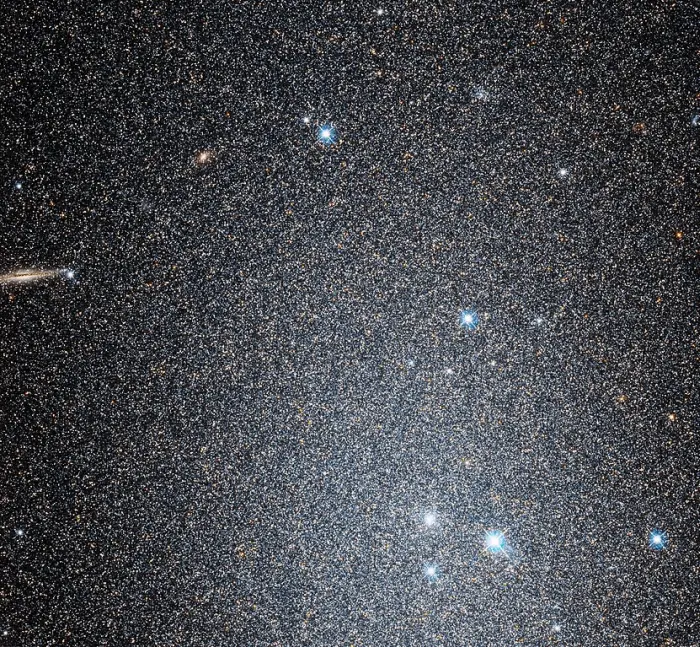
Caldwell 17, also known as NGC 147, is a dwarf galaxy located roughly 2.5 million light-years from Earth. It is a member of the Local Group of galaxies, which is dominated by our Milky Way and the Andromeda Galaxy. Caldwell 17, like its neighbor Caldwell 18, is a distant satellite of the Andromeda Galaxy. Just as the planets in the solar system are gravitationally bound to the Sun, so are these smaller galaxies bound to their much more massive galactic host. While many classes of galaxies can exist as satellites, dwarf spheroidal galaxies (small, dim, spherical-shaped galaxies) like Caldwell 17 have been observed in this role more frequently than any other type of galaxy. Dwarf satellite galaxies tend to appear very diffuse and dim, so they can be difficult to spot (especially in light-polluted or hazy skies). Caldwell 17 is no exception. It has an apparent magnitude of 9.5, and observers will need a small telescope set up in a dark location to detect the faint galaxy. Caldwell 17 is located in the southern edge of the constellation Cassiopeia, between the constellation’s “W” pattern and the Andromeda Galaxy. Image credit: NASA, ESA, and A. Ferguson (University of Edinburgh, Institute for Astronomy); Processing: Gladys Kober (NASA/Catholic University of America) (CC BY 2.0)
NGC 185 (Caldwell 18)
NGC 185 (C18) is a dwarf spheroidal galaxy located 2.05 million light-years away. Like its neighbour NGC 147, it a satellite of the larger Andromeda Galaxy. It has an apparent magnitude of 10.1 and an angular size of 11.7 by 10 arcminutes.
The galaxy has an active galactic nucleus (AGN) and is sometimes classified as a type 2 Seyfert galaxy. It is the only known Seyfert galaxy in the Local Group.
NGC 185 was discovered by William Herschel on November 30, 1787. It was first photographed by the American astronomer James Edward Keeler between 1898 and 1900. Keeler used the Crossley telescope (36-inch/910mm), the reflecting telescope located at Lick Observatory in California, to image the galaxy.
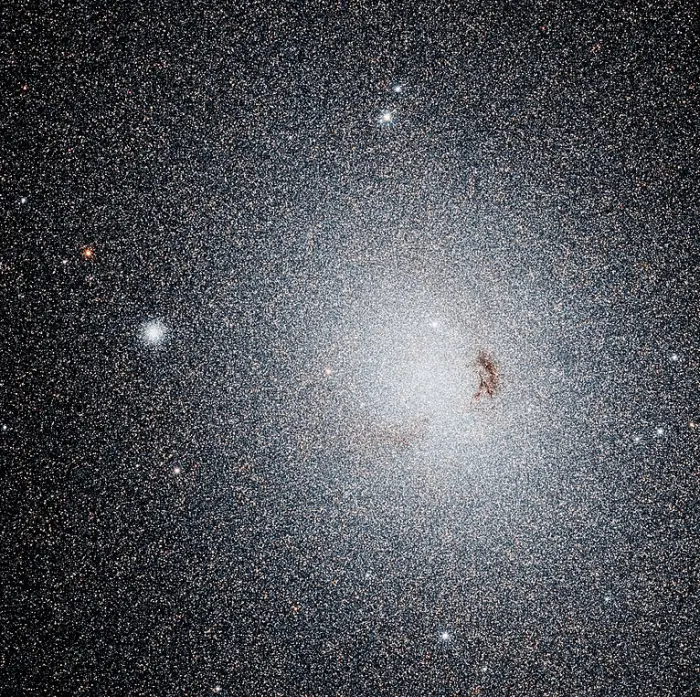
Located in Cassiopeia, not far from Caldwell 17, Caldwell 18 is a dwarf galaxy and a satellite of the Andromeda Galaxy. Also known as NGC 185, it is a member of the Local Group of galaxies. Caldwell 17 is notable for its active galactic nucleus, a region at the center of the galaxy that emits strong radiation over part of the electromagnetic spectrum. Some astronomers classify Caldwell 18 as a type II Seyfert galaxy. These types of galaxies appear intensely bright when observed at infrared wavelengths despite their unremarkable brightness in visible wavelengths. Although the classification of Caldwell 18 remains up for debate within the astronomical community, if it is indeed a Seyfert galaxy, then it would be the only one known in the Local Group and the closest one to Earth. This Hubble image combines observations taken with Hubble’s Wide Field Camera 3 in visible and infrared wavelengths. Clouds of dust appear near the galaxy’s center, and a globular star cluster appears to the left. These Hubble observations helped astronomers study the characteristics of globular clusters in nearby dwarf galaxies. Credit: NASA, ESA, and A. Ferguson (University of Edinburgh, Institute for Astronomy); Processing: Gladys Kober (NASA/Catholic University of America) (CC BY 2.0)
Ghost of Cassiopeia (IC 63) and IC 59
IC 59 and IC 63 are emission/reflection nebulae located approximately 550 light-years away. They appear near the hot blue variable star Gamma Cassiopeiae, the central star of Cassiopeia’s W. They have apparent magnitudes of 10.
The nebulae are difficult to spot in telescopes because they have low surface brightness and appear too close to the luminous Gamma Cassiopeiae. They can be seen in medium-sized telescopes in good conditions. Their ghostly appearance makes them popular astrophotography targets.
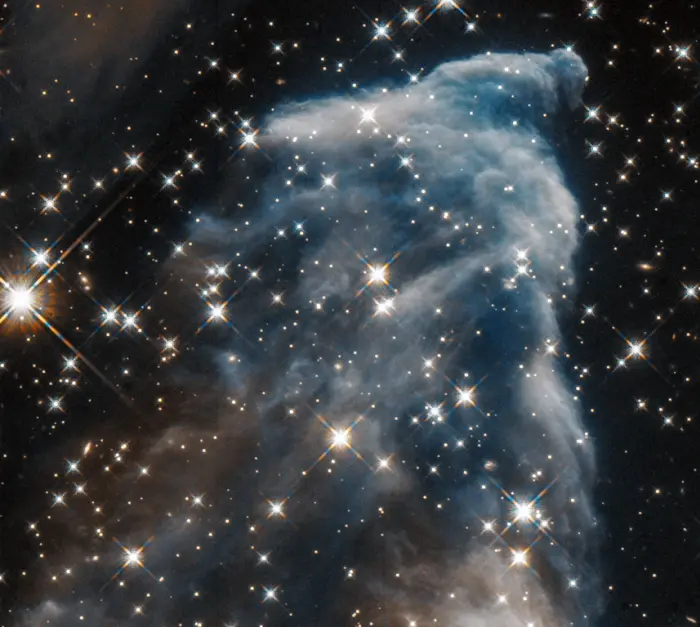
The Ghost of Cassiopeia (IC 63) captured in near-infrared light by the Hubble Space Telescope, image credit: NASA, ESA, and STScI; Acknowledgment: H. Arab (University of Strasbourg) (PD)
Cannonball Pulsar (PSR J0002+6216)
The Cannonball Pulsar is a pulsar – a rotating neutron star whose beams of electromagnetic radiation point towards Earth – located 6,500 light-years away. It is the remnant of a star that went out as a supernova around 10,000 years ago. The supernova remnant is known as the Medulla Nebula and catalogued as CTB 1 (Abell 85, G116.9+00.1). It was discovered in 1960.
The pulsar PSR J0002+6216 was discovered in 2017. It is associated with a pulsar wind nebula. It was nicknamed the Cannonball Pulsar because it is one of the fastest moving pulsars discovered to date. The stellar remnant has moved 53 light years from the location of the supernova, leaving behind a tail 13 light-years long. The progenitor star had an estimated mass 13 to 15 times that of the Sun.
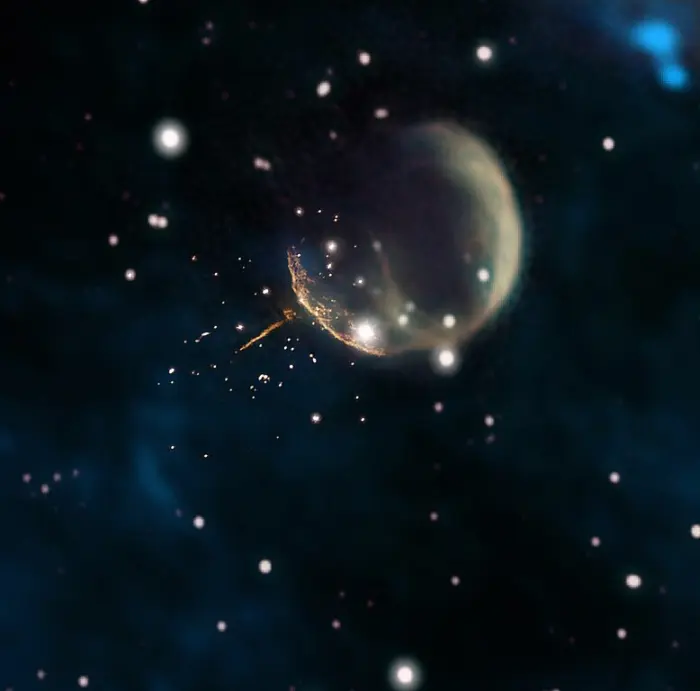
Observations using the Very Large Array (orange) reveal the needle-like trail of pulsar J0002+6216 outside the shell of its supernova remnant, shown in image from the Canadian Galactic Plane Survey. The pulsar escaped the remnant some 5,000 years after the supernova event. Image credit – composite by Jayanne English, University of Manitoba; F. Schinzel et al.; NRAO/AUI/NSF; DRAO/Canadian Galactic Plane Survey; and NASA/IRAS. (CC BY 3.0)
VdB 1 (LBN 578, Magakian 3)
VdB1 is a reflection nebula located around 1,600 light-years away. It appears just southeast of the giant star Caph, the rightmost star of Cassiopeia’s W. The nebula is also catalogued as LBN 578 and Magakian 3. It is difficult to spot because it is overwhelmed by the glare of the giant star. It appears in the same field of view as the dark nebula LDN 1265.
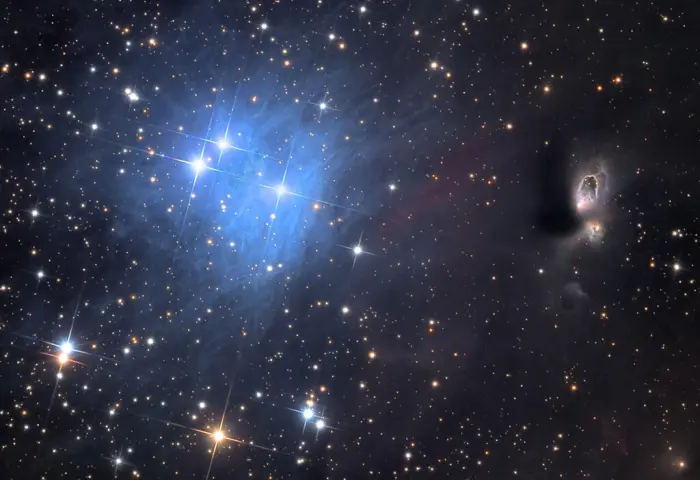
VdB1, image credit: Adam Block/Mount Lemmon SkyCenter/University of Arizona (CC BY-SA 4.0)
NGC 129
NGC 129 is an open cluster located 5,450 light-years away. It appears roughly halfway between Caph and Gamma Cassiopeiae. It has an apparent magnitude of 6.5 and can be seen in binoculars. With an apparent size of 21 arcminutes, the cluster is quite large but it is not particularly dense. It has an estimated age of 76 million years.
NGC 129 was discovered by William Herschel on December 16, 1788.
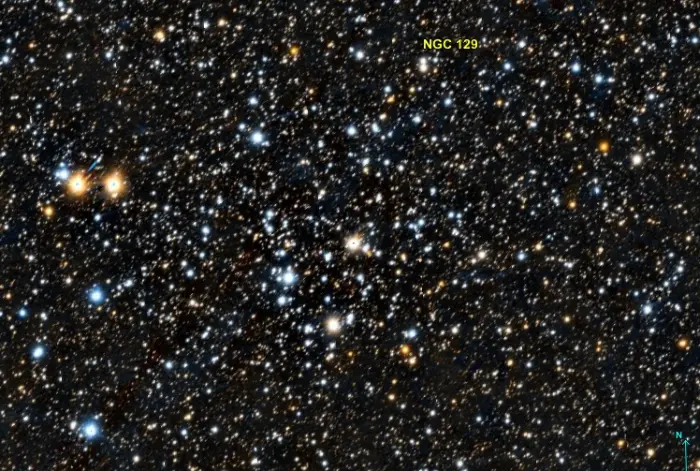
NGC 129, image created using the Aladin Sky Atlas software from the Strasbourg Astronomical Data Center and Pan-STARRS (Panoramic Survey Telescope And Rapid Response System) public data, credit: Donald Pelletier (CC BY-SA 4.0)
NGC 136
NGC 136 is an open cluster with an apparent magnitude of 11.0 and an apparent size of 3.2 arcminutes. It lies in the region of Cassiopeia’s W. The cluster appears small, compressed and faint. It was discovered by William Herschel on 26 November, 1788.
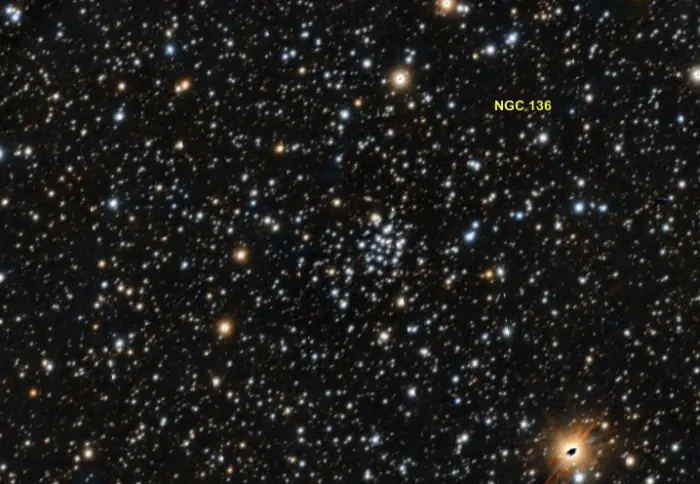
NGC 136, image created using the Aladin Sky Atlas software from the Strasbourg Astronomical Data Center and Pan-STARRS (Panoramic Survey Telescope And Rapid Response System) public data, credit: Donald Pelletier (CC BY-SA 4.0)
Sailboat Cluster – NGC 225
The Sailboat Cluster (NGC 225) is an open star cluster located approximately 2,200 light-years away. It has an estimated age of 100-150 million years. It is sometimes also called the Broken Heart Cluster.
With an apparent magnitude of 7 and an apparent size of 12 arcminutes, the cluster is easily observed in binoculars and small telescopes.
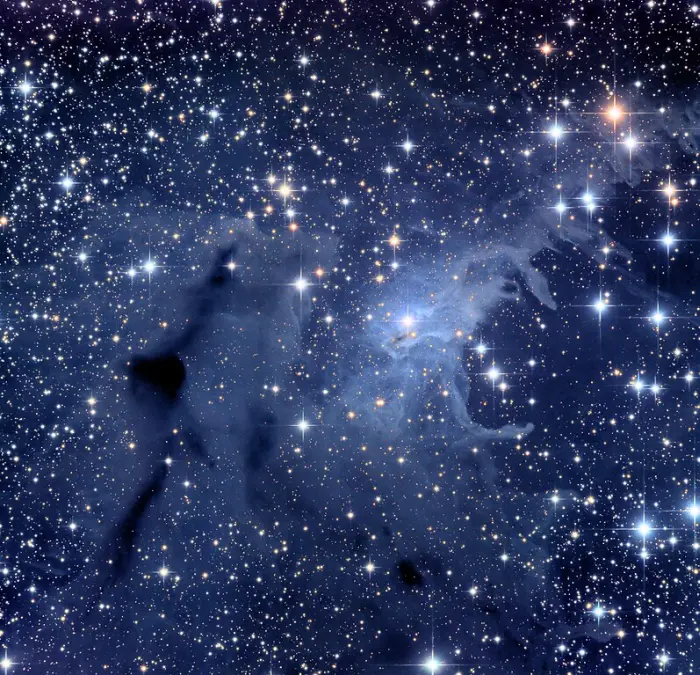
VdB4 nebula with the Sailboat Cluster (NGC 225), image credit: Wikimedia Commons/JSchulman555 (CC BY-SA 3.0)
NGC 278
NGC 278 is a spiral galaxy located 39 million light-years away. It appears near the border with the constellation Andromeda. The galaxy has a weak bar structure and an incomplete ring surrounding the bar. It has a diameter of only 23,000 light-years.
NGC 278 has an apparent magnitude of 11.5. It was discovered by William Herschel on December 11, 1786.
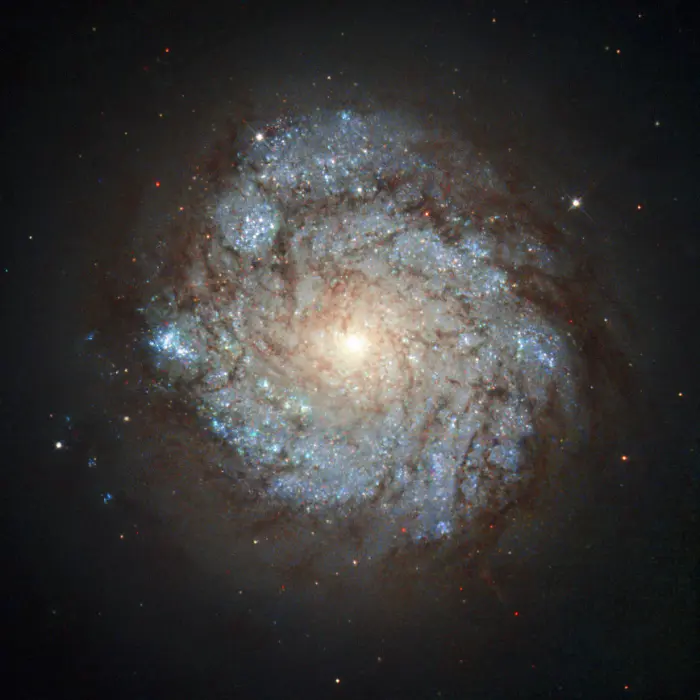
This image, taken by the NASA/ESA Hubble Space Telescope’s Wide Field Planetary Camera 2, shows a spiral galaxy named NGC 278. This cosmic beauty lies some 38 million light-years away in the northern constellation of Cassiopeia (The Seated Queen). While NGC 278 may look serene, it is anything but. The galaxy is currently undergoing an immense burst of star formation. This flurry of activity is shown by the unmistakable blue-hued knots speckling the galaxy’s spiral arms, each of which marks a clump of hot newborn stars. However, NGC 278’s star formation is somewhat unusual; it does not extend to the galaxy’s outer edges, but is only taking place within an inner ring some 6500 light-years across. This two-tiered structure is visible in this image — while the galaxy’s centre is bright, its outer regions are much darker. This odd configuration is thought to have been caused by a merger with a smaller, gas-rich galaxy — while the turbulent event ignited the centre of NGC 278, the dusty remains of the small snack then dispersed into the galaxy’s outer regions. Whatever the cause, such a ring of star formation, called a nuclear ring, is highly unusual in galaxies without a bar at their centre, making NGC 278 a very intriguing sight. Image credit: ESA/Hubble & NASA and S. Smartt (Queen’s University Belfast) (CC BY 4.0)
IC 289
IC 289 is a planetary nebula located approximately 5,190 light-years away, near the border with Camelopardalis. It has an apparent visual magnitude of 12 and an apparent size of 0.76454663 by 0.76454335 arcminutes. The nebula’s central star is a hot O-type star of the spectral type O(H).
The nebula was discovered by the American astronomer Lewis Swift on September 2, 1888.
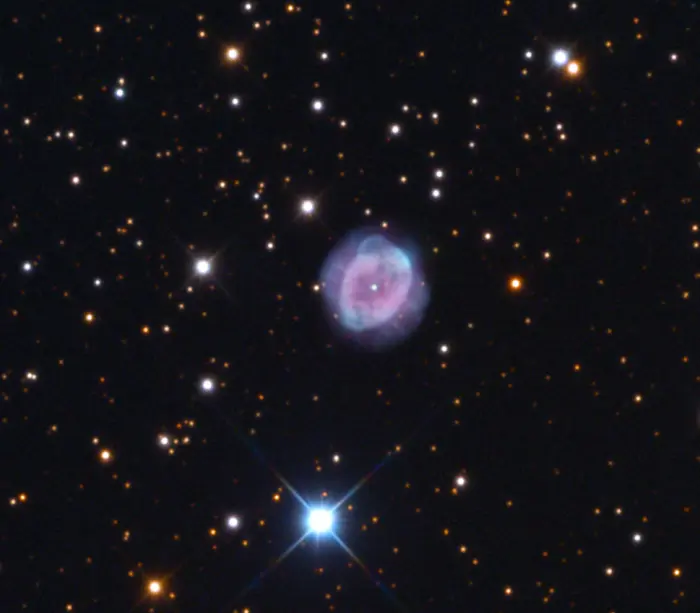
IC 289, image: Adam Block/Mount Lemmon SkyCenter/University of Arizona (CC BY-SA 4.0)
NGC 381
NGC 381 is an open cluster located approximately 3,120 light years away. It appears near Gamma Cassiopeiae, the central star of Cassiopeia’s W. It has an apparent magnitude of 9.3 and appears around 7 arcminutes across. The cluster was discovered by William Herschel on November 3, 1787.
The cluster has a radius of 15 light-years and contains around 350 stars. It has an estimated age of 316 million years.
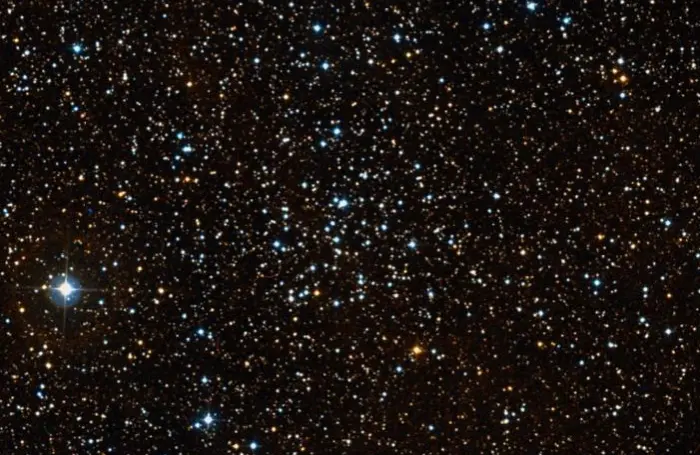
NGC 381, image: Wikisky (DSS2)
NGC 436
NGC 436 is another open cluster in the region of Cassiopeia’s W. It appears near Ruchbah and the brighter Owl Cluster (NGC 457).
The cluster has an apparent magnitude of 8.8 and lies 7,922 light years away. It was discovered by William Herschel on November 3, 1787.
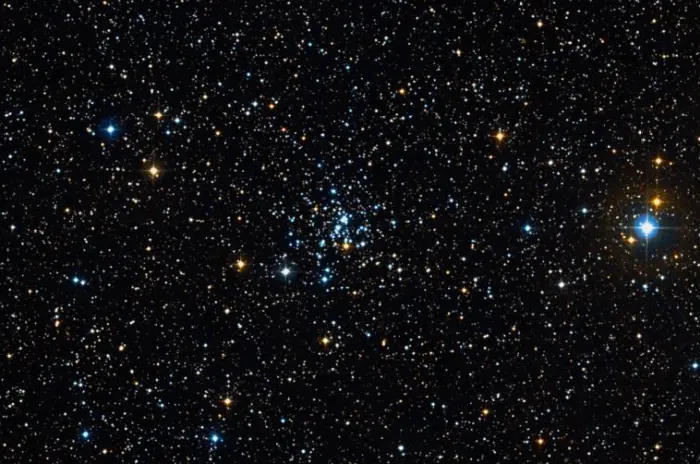
NGC 436, image: Wikisky (DSS2)
NGC 637
NGC 637 is an open star cluster discovered by William Herschel on November 9, 1787. It has an apparent magnitude of 8.2 and an apparent size of 4.2 arcminutes, corresponding to a physical radius of 9.8 light-years. It lies 7,045 light-years away in the Perseus Arm of the Milky Way.
The cluster appears 1.5 degrees west-northwest of Segin. It has an estimated age of 5 – 15 million years. It can be observed in small telescopes. Its brightest members are 10th magnitude stars.
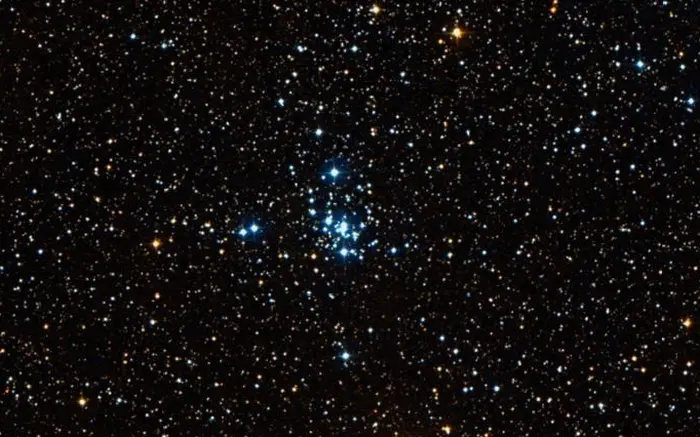
NGC 637, image: Wikisky (DSS2)
NGC 654
NGC 654 is an open cluster with an apparent magnitude 6.5, located 7,830 light-years away. It was discovered by Caroline Herschel on September 27, 1783. It appears 2.5 degrees northeast of Ruchbah, in the same area as NGC 663, NGC 659, and IC 166.
NGC 654 is sometimes called the Fuzzy Butterfly Cluster. It has an apparent size of 5 arcminutes and can be seen in binoculars and small telescopes. It is believed to be only 14 million years old. The cluster is probably part of the young stellar association Cassiopeia OB8, which also includes Messier 103, NGC 659, and NGC 663.
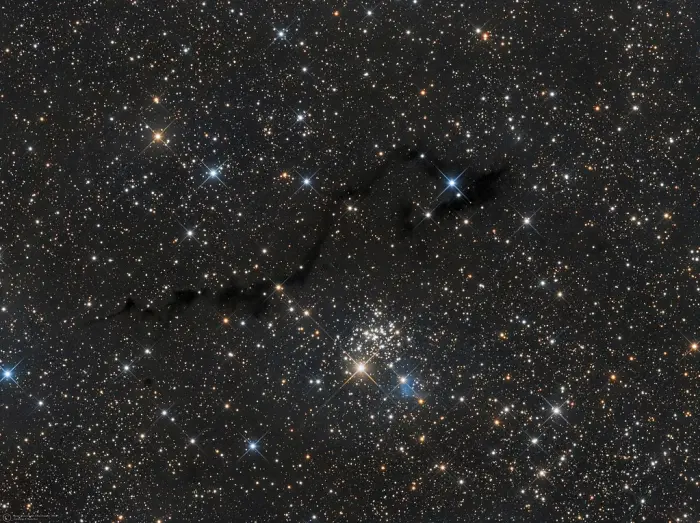
NGC 654, image credit: Antonio F. Sánchez (CC BY-SA 4.0)
Yin-Yang Cluster (NGC 659)
The Yin-Yang Cluster (NGC 659) is an open cluster located 8,200 light-years away. It is one of the star clusters in the region between Segin and Ruchbah, the leftmost stars of Cassiopeia’s W. NGC 659 appears close to the brighter NGC 663 in the sky. It has an estimated age of only 20 million years.
The cluster has an apparent visual magnitude of 7.9 and an angular size of 6 arcminutes. It was discovered by Caroline Herschel in 1783.
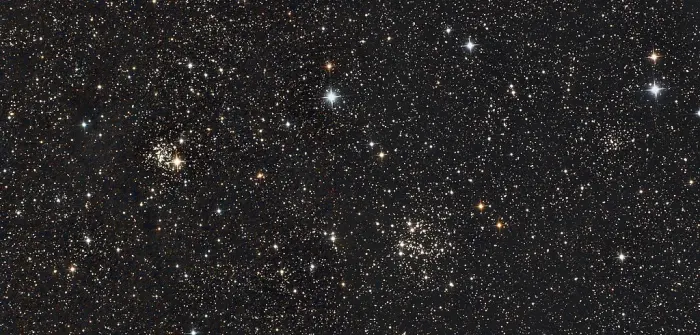
The open clusters NGC 654 (left), NGC 663 (centre) and NGC 659 (right), image credit: Wikimedia Commons/Astrophoto Andy (CC0 1.0)
NGC 1027
NGC 1027 is an open star cluster located 3,100 light-years away. It has an apparent magnitude of 6.7 and an apparent size of 20 arcminutes. It was discovered by William Herschel on November 3, 1787.
The cluster has an estimated age of 355 million years. It appears in the eastern portion of Cassiopeia, in the region between the Heart and Soul nebulae. It lies much closer to us and is not physically related to the nebulae. The brightest star in the cluster shines at magnitude 9.3.
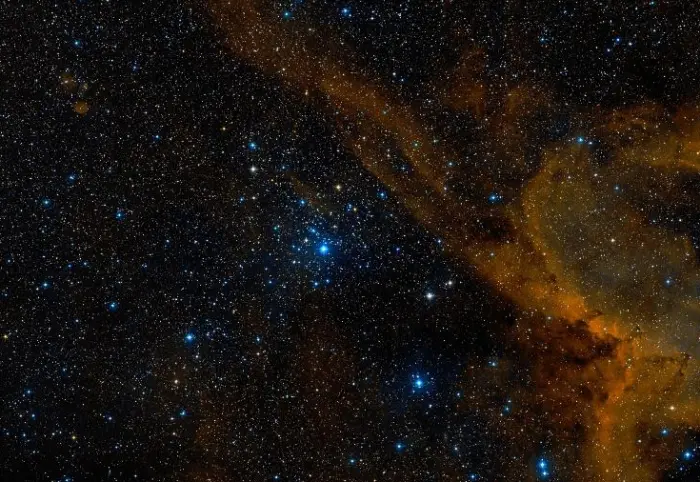
NGC 1027, image: Wikisky (DSS2)
Widow’s Web Cluster (NGC 7790)
NGC 7790 is a young open cluster located 10,760 light-years away. It has an apparent magnitude of 8.5 and an apparent size of 7.4 arcminutes. It is sometimes known as the Widow’s Web Cluster.
The cluster has an estimated age of 60-80 million years. It was discovered by William Herschel on December 16, 1788. It lies a quarter of a degree from the fainter open cluster NGC 7788.
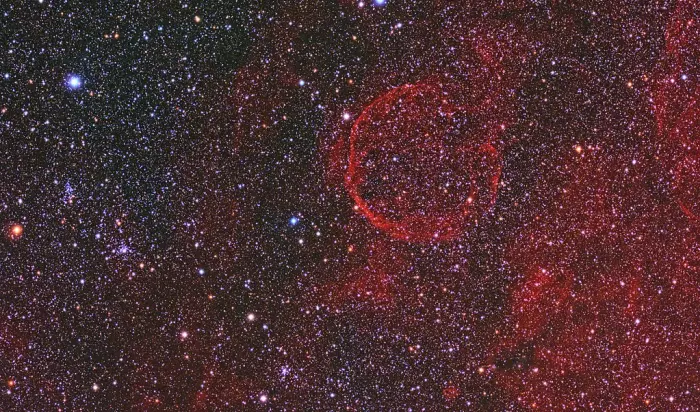
The open clusters NGC 7790 (left) and NGC 7788 (to the lower right of NGC 7790) and the supernova remnant CTB1 (centre right), image credit: Kees Scherer (CC BY-SA 4.0)
IC 10
IC 10 is an irregular galaxy located 2.5 million light-years away. It has an apparent magnitude of 10.4 and an apparent size of 6.8 by 5.9 arcminutes.
IC 10 is a member of the Local Group of galaxies. It has a diameter of 5,000 light-years. The galaxy is smaller than the Small Magellanic Cloud, but has a similar luminosity.
IC 10 is the only starburst galaxy in the Local Group. It hosts many star forming regions that emerged only in the last 10 million years.
IC 10 has a vast envelope of hydrogen gas that extends far beyond the part of galaxy that can be seen in visible light. The visible part of IC 10 appears to rotate in a different direction than the envelope.
IC 10 was discovered by the American astronomer Lewis Swift in 1887. American astronomer Nicholas Mayall was the first to suggest that it was an extragalactic object in 1935. In 1962, the galaxy was discovered to be approaching the Milky Way at 350 km/s, indicating that it was a member of the Local Group of galaxies.
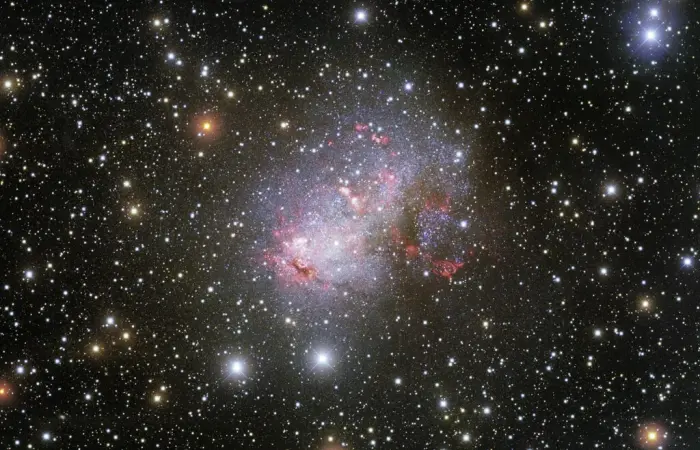
This striking image from NOIRLab’s Kitt Peak National Observatory (KPNO) presents a portrait of the irregular galaxy IC 10, a disorderly starburst galaxy close to the Milky Way. As well as a population of bright young stars, this irregular galaxy harbors exotic Wolf-Rayet stars and a black hole. IC 10 lies around 2 million light-years from Earth in the direction of the constellation of Cassiopeia. Though this distance seems huge, it puts IC 10 in the ever-growing Local Group of galaxies. Image credit: KPNO/NOIRLab/NSF/AURA. Data obtained and processed by: P. Massey (Lowell Obs.), G. Jacoby, K. Olsen, & C. Smith (NOAO/AURA/NSF). Image processing: Travis Rector (University of Alaska Anchorage), Mahdi Zamani & Davide de Martin (CC BY 4.0)
IRAS 23304+6147
IRAS 23304+6147 is a protoplanetary nebula located approximately 14,000 light-years away. The central star in the nebula is a yellow supergiant of the spectral type G2Ia. It has a radius 171 times that of the Sun and, with a surface temperature of 5,900 K, it shines with 8,318 solar luminosities. The supergiant is classified as an irregular variable star. Its brightness varies from magnitude 12.99 to 13.15.
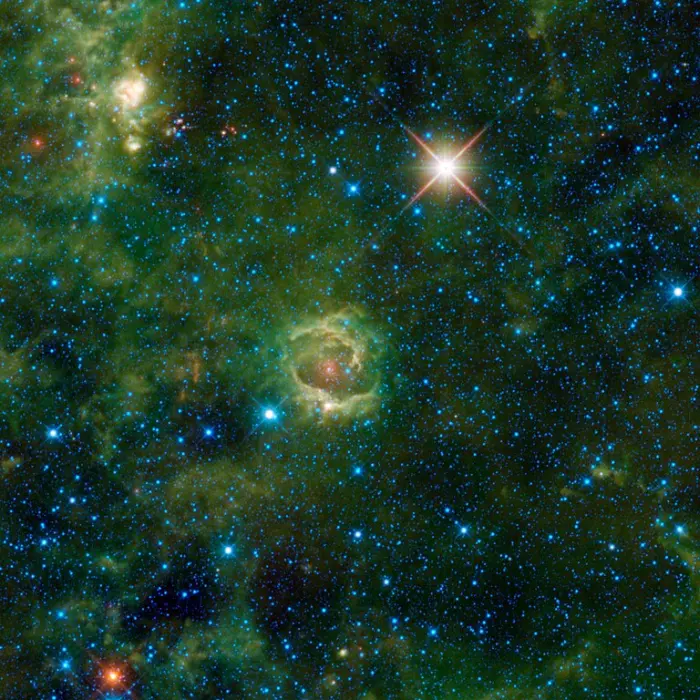
Image of emission nebula LBN 114.55+00.22. In the lower left corner of the image is the bright red star IRAS 23304+6147, which is in the last phase of its life. Another bright object in this image is the supergiant variable star HIP 117078, seen above and to the right of the nebula. Image credit: NASA/JPL-Caltech/WISE Team (PD)